TOSHIBA RD-88DT User Manual
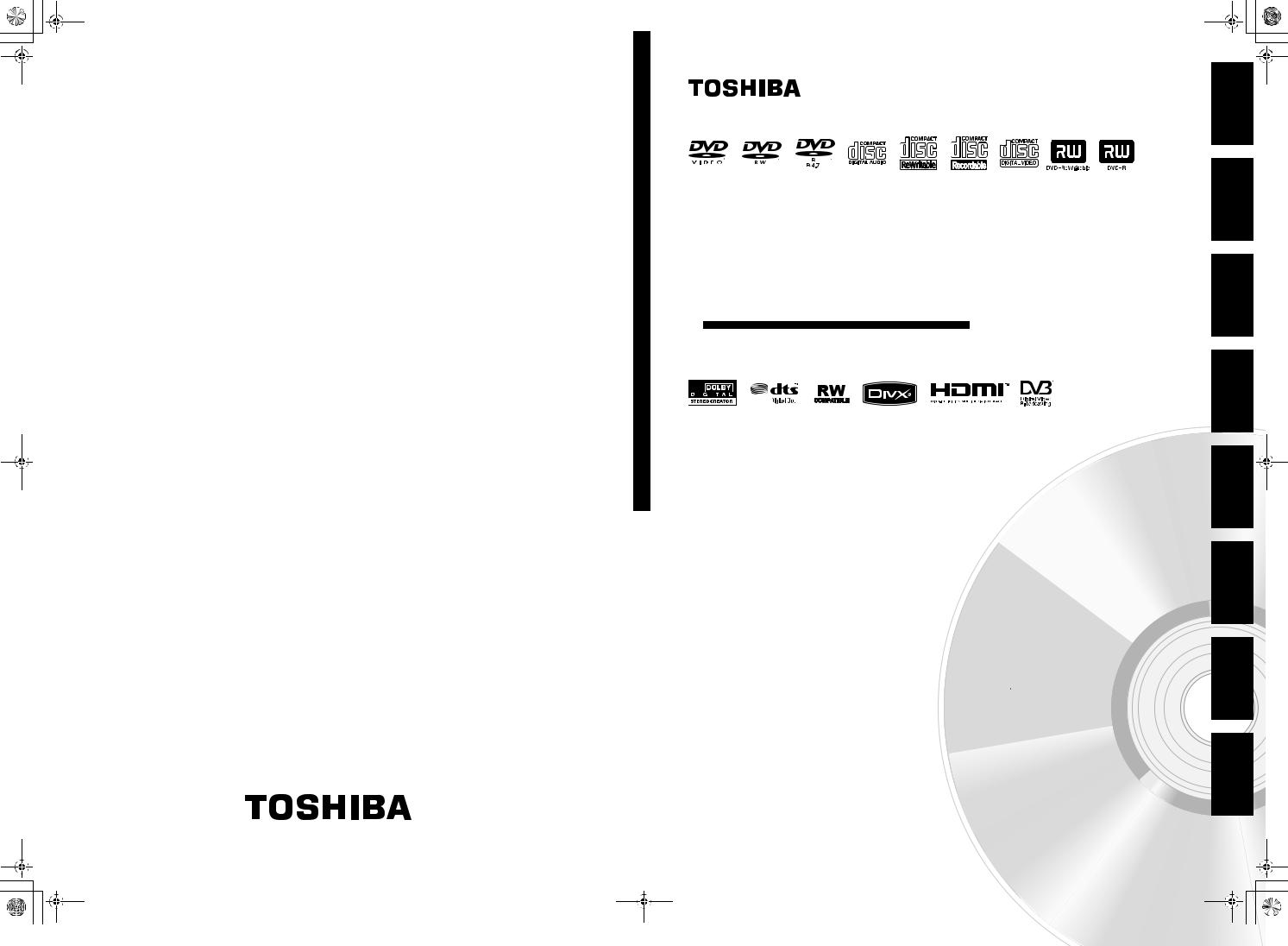
COV_E2N70_71FD_EN.fm Page 1 Thursday, February 28, 2008 12:27 PM
98DTKF-RD / 88DTKF-RD Recorder Video / DVD & HDD TOSHIBA
|
Introduction |
|
HDD & DVD / Video Recorder |
Connections |
|
|
||
RD-88DTKF |
Basic |
|
RD-98DTKF |
||
Setup |
||
OWNER’S MANUAL |
|
|
|
Recording |
Playback
Others Setup Function Editing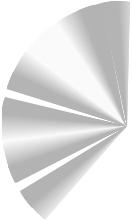
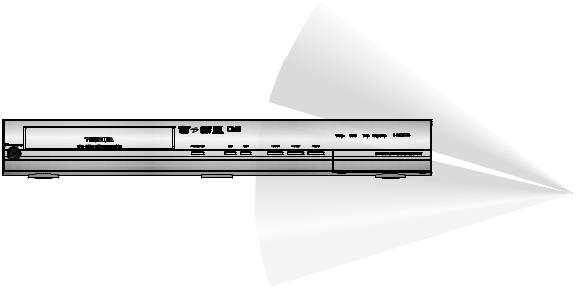
Printed in China |
1VMN25053 / E2N7071FD |
© 2008 Toshiba Corporation |
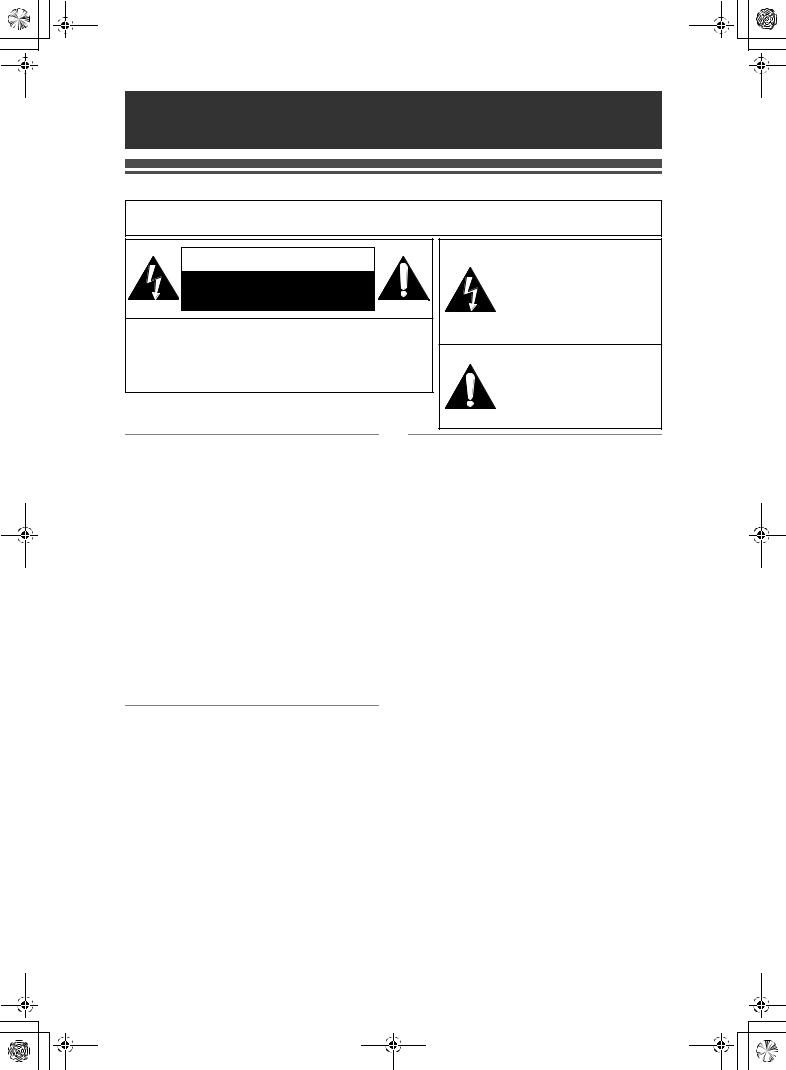
E2N7071FD_EN.book Page 2 Thursday, February 28, 2008 12:21 PM
Introduction
Precautions
WARNING: TO REDUCE THE RISK OF FIRE OR ELECTRIC SHOCK, DO NOT EXPOSE THIS APPLIANCE TO RAIN OR MOISTURE.
CAUTION
RISK OF ELECTRIC SHOCK
DO NOT OPEN
CAUTION:
TO REDUCE THE RISK OF ELECTRIC SHOCK, DO NOT REMOVE COVER (OR BACK). NO USER SERVICEABLE PARTS INSIDE. REFER SERVICING TO QUALIFIED SERVICE PERSONNEL.
The important note is located on the rear of the cabinet.
The lightning flash with arrowhead symbol, within an equilateral triangle, is intended to alert the user to the presence of uninsulated “dangerous
voltage” within the product’s enclosure that may be of sufficient magnitude to constitute a risk of electric shock to persons.
The exclamation point within an equilateral triangle is intended to alert the user to the presence of important operating and maintenance (servicing) instructions in the literature accompanying the appliance.
Laser Safety
This unit employs a laser. Only a qualified service personnel should remove the cover or attempt to service this unit, due to the possibility of eye injury.
CAUTION: USE OF CONTROLS OR ADJUSTMENTS OR PERFORMANCE OF PROCEDURES OTHER THAN THOSE SPECIFIED HEREIN MAY RESULT IN HAZARDOUS RADIATION EXPOSURE.
CAUTION: VISIBLE AND INVISIBLE LASER RADIATION WHEN OPEN AND INTERLOCK DEFEATED. DO NOT STARE INTO BEAM.
LOCATION: INSIDE, NEAR THE DECK
MECHANISM.
Power Supply
The power supply is connected and the unit is live when the mains cable is plugged into a 220 - 240 V~, 50 Hz AC outlet. To operate the unit, press
[B ON\STANDBY].
WARNING: LIVE PARTS INSIDE.
DO NOT REMOVE ANY SCREWS.
Caution
1.Do not attempt to open the cabinet. There are no parts inside you can service. Refer all servicing to qualified service personnel.
2.Slots and openings in the cabinet at the sides and underneath are provided for ventilation. To ensure reliable operation and to protect the unit from overheating, these openings must not be blocked or covered.
Avoid installation in enclosed spaces such as bookcases unless suitable ventilation is provided.
3.Keep the unit away from radiators and other heat sources.
4.Avoid use near strong magnetic fields.
5.Do not push objects of any kind into the unit through the cabinet slots or openings as they could touch electrically live parts or short circuit parts resulting in a fire or electric shock.
6.Do not spill liquid on the unit. If liquid is spilled and enters the unit, consult qualified service personnel.
7.Do not stand the unit vertically. Use the unit in a horizontal (flat) position only.
8.Before attempting to operate the unit, make sure that the timer recording mode is off.
9.This product is in Stand-by mode when turned off while the mains cable is connected.
10.Do not place any combustible objects on the device (candles, etc.).
11.Before moving the unit, be sure to remove any discs and unplug the mains cable from the AC outlet.
12.Disconnect the mains plug to shut off when find troubles or not in use.
13.The mains plug shall remain readily operable.
14.Read both manual instructions to ensure correct and safe installation and interconnection of the unit in multimedia systems.
15.Keep the distances 20 cm around apparatus of ventilation openings.
2 EN
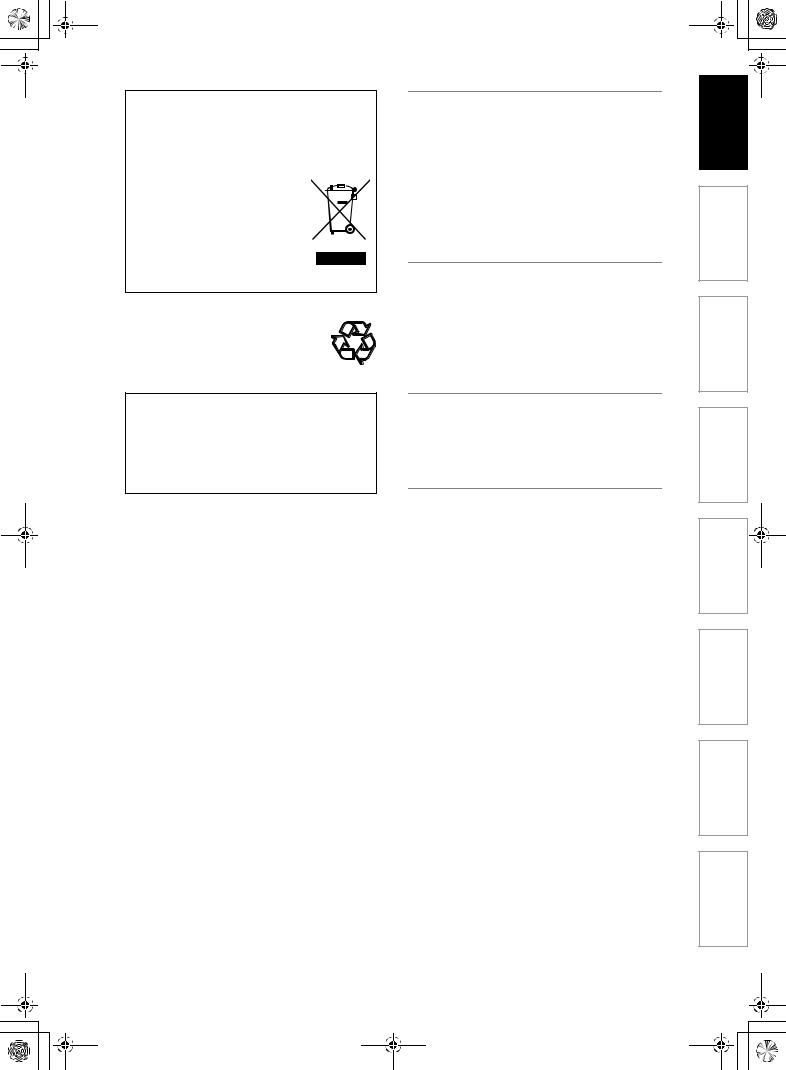
E2N7071FD_EN.book Page 3 Thursday, February 28, 2008 12:21 PM
A NOTE ABOUT RECYCLING
This product’s packaging materials are recyclable and can be reused. Please dispose of any materials in accordance with your local recycling regulations.
This product consists of materials which can be recycled and reused if disassembled by a specialised company.
Batteries should never be thrown away or incinerated but disposed of in accordance with your local regulations concerning chemical wastes.
Make your contribution to the environment!!!
• Exhausted batteries do not belong in the dustbin.
•You can dispose of them at a collection point for exhausted batteries or special waste.
•Contact your council for details.
For Customer Use:
Carefully read the Model No. and Serial No. located at the back of the unit and enter the information below. Retain this information for future reference.
Model No. _____________________
Serial No. _____________________
Installation Location
For safety and optimum performance of this unit:
•Install the unit in a horizontal and stable position.
•Do not place anything directly on top of the unit.
•Do not place the unit directly on top of the TV.
•Shield the unit from direct sunlight and keep away from sources of intense heat. Avoid dusty or humid locations. Avoid locations with insufficient ventilation for suitable heat dissipation. Do not block the ventilation holes on the sides of the unit. Avoid locations subject to strong vibration or strong magnetic fields.
Avoid the Hazards of Electrical Shock
and Fire
•Do not handle the mains cable with wet hands.
•Do not pull on the mains cable to disconnect it from AC outlet. Grasp it by the plug.
•If, by accident, water is spilled on the unit, unplug the mains cable immediately and take the unit to an authorised service centre for servicing.
Moisture Condensation Warning
Moisture condensation may occur inside the unit when it is moved from a cold place to a warm place, after heating a cold room, or under conditions of high humidity. Do not use the unit for at least 2 hours to allow the inside to dry.
About Copyright
Unauthorised copying, broadcasting, public performance and lending of discs are prohibited. This product incorporates copyright protection technology that is protected by U.S. patents and other intellectual property rights. Use of this copyright protection technology must be authorised by Macrovision, and is intended for home and other limited viewing uses only unless otherwise authorised by Macrovision. Reverse engineering or disassembly is prohibited.
Recording Setup Basic Connections Introduction
Playback
Others Setup Function Editing
EN 3
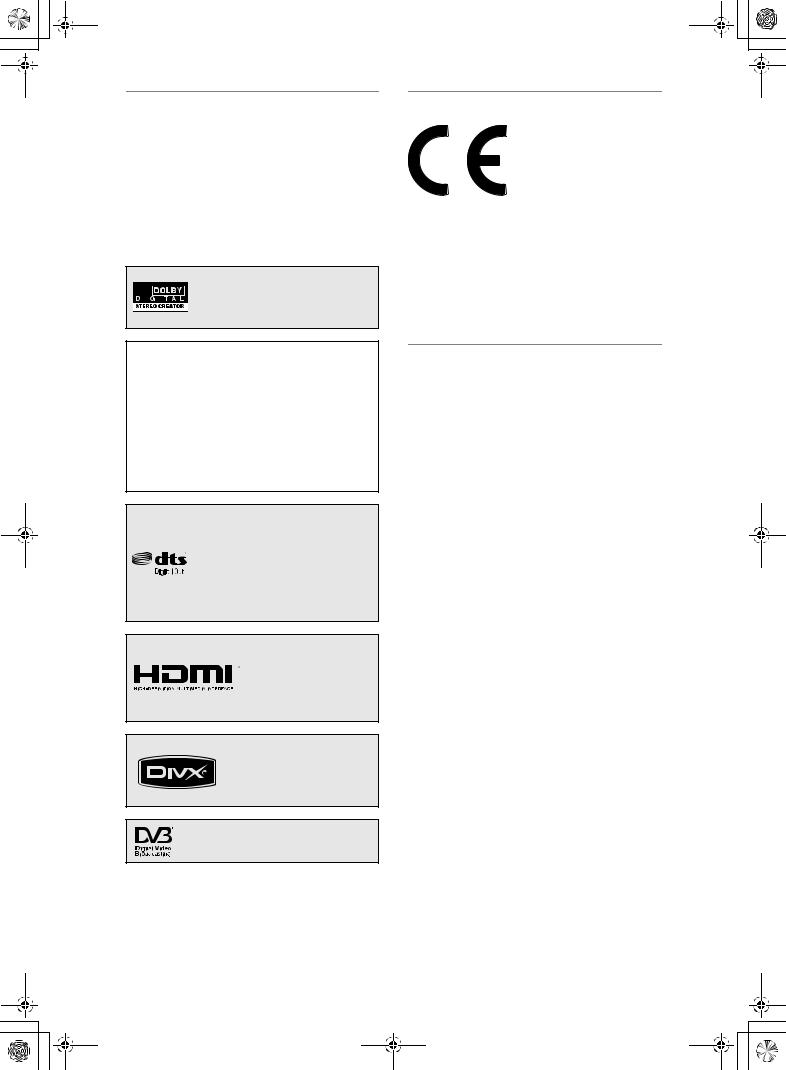
E2N7071FD_EN.book Page 4 Thursday, February 28, 2008 12:21 PM
Notice for the Progressive Scan Outputs
Consumers should note that not all high definition television sets are fully compatible with this product and may cause artifacts to be displayed in the picture. In case of picture problems with 480 or 576 progressive scan output, it is recommended that the user switch the connection to the ‘standard definition’ output. If there are questions regarding your TV set compatibility with this 480p or 576p product, please contact our customer service centre.
Manufactured under license from Dolby Laboratories. Dolby and the double-D symbol are trademarks of Dolby Laboratories.
“Dolby® Digital Stereo Creator enables consumers to create stereo DVD-Videos with stunning Dolby Digital sound tracks at home. The technology, when utilised instead of PCM recording, also saves recordable disc space, allowing for higher video resolution or extended recording time on each DVD. DVDs mastered using Dolby Digital Stereo Creator will play back on all DVD-Video players.”
Note: This is true when the players are compatible with actual recordable DVD discs.
Manufactured under license under U.S. Patent #: 5,451,942 & other U.S. and worldwide patents issued & pending. DTS and DTS Digital Out are registered trademarks and the DTS logos and Symbol are trademarks of DTS, Inc. © 19962007 DTS, Inc. All Right Reserved.
HDMI, the HDMI logo and High-Definition Multimedia Interface are trademarks or registered trademarks of HDMI Licensing LLC.
DivX, DivX Certified, and associated logos are trademarks of DivX, Inc. and are used under license.
DVB is a registered trademark of the
DVB project
EU Conformity Statement
“This product is marked with “CE” and complies therefore with the applicable harmonized European standards listed under the Low Voltage Directive 2006/95/EC and the EMC Directive 2004/108/EC.”
Responsible for CE-marking is
TOSHIBA INFORMATION SYSTEMS (U.K.) LTD, Toshiba Court, Weybridge Business Park, Addlestone Road, Weybridge,
Surrey, KT15 2UL, United Kingdom
Maintenance
CLEANING THE UNIT
Use a soft cloth slightly moistened with a mild detergent solution. Do not use solutions containing alcohol, spirits, ammonia or abrasive.
CLEANING DISCS
If a disc becomes dirty, clean it with a cleaning cloth. Wipe the disc from the centre out. Do not wipe in a circular motion.
Do not use solvents such as benzine, thinner, commercially available cleaners, detergent, abrasive cleaning agents or antistatic spray intended for analogue records.
DISC HANDLING
Handle the discs so that fingerprints and dust do not adhere to the disc surfaces.
Always store the disc in its protective case when it is not in use.
HDD HANDLING
•HDD is a precision apparatus that is susceptible to vibration, strong impact or dirt. Depending on the installation environment or handling, the unit may become partially damaged or in the worst case, recording or replaying may not be available. Especially while the HDD is in motion, do not subject it to vibration or strong impact or pull out the power plug. And if a power failure occurs, the content of the recording / replaying programme may be lost.
•HDD rotates at high speed when in operation. Be sure that rotation has stopped and then move the unit without subjecting it to strong impact or vibration.
SERVICING
If the unit becomes inoperative, do not try to correct the problem by yourself. There are no user serviceable parts inside. Turn the unit off, unplug the mains cable, and consult your dealer or an authorised service centre.
4 EN
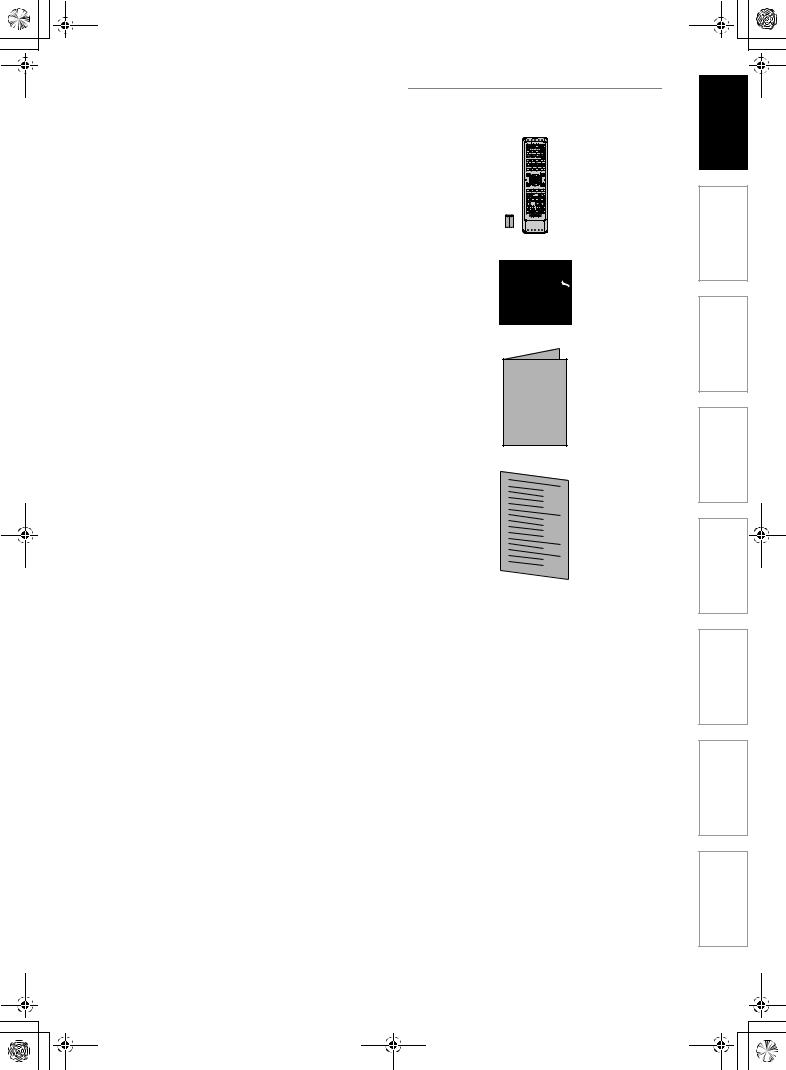
E2N7071FD_EN.book Page 5 Thursday, February 28, 2008 12:21 PM
CLEANING THE DISC LENS
If the unit does not perform correctly even though you have referred to “Troubleshooting” and the relevant sections in the Owner’s Manual, the laser optical pickup unit may be dirty. Consult your dealer or an authorised service centre for inspection and cleaning of the laser optical pickup unit.
Accessories Supplied
• Remote control with two R6 (AA) batteries
1 2 3
4 5 6
7 8 9
0
SE-R0308
• RF cable
• Owner’s Manual
Owner's Manual |
• Quick Setup Guide
Recording Setup Basic Connections Introduction
Playback
Others Setup Function Editing
EN 5
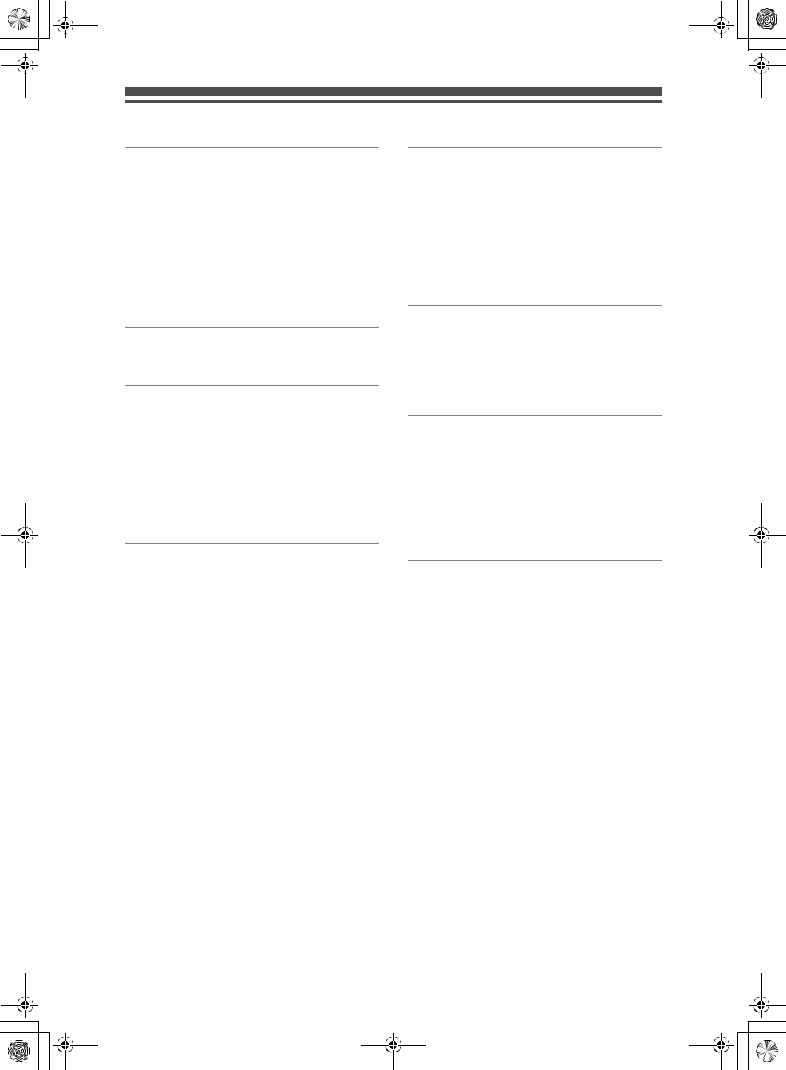
E2N7071FD_EN.book Page 6 Thursday, February 28, 2008 12:21 PM
Table of Contents |
|
Introduction ........................................... |
2 |
Precautions .......................................................... |
2 |
Features ............................................................... |
7 |
Guide to the Owner’s Manual............................... |
8 |
Functional Overview........................................... |
11 |
Installing Batteries in the Remote Control.......... |
14 |
Switching HDD / DVD mode .............................. |
15 |
Guide to On-Screen Displays............................. |
15 |
Front Panel Display Guide ................................. |
19 |
Connections ........................................ |
20 |
Connections ....................................................... |
20 |
Basic Setup.......................................... |
24 |
Initial Setting....................................................... |
24 |
Channel Setting.................................................. |
25 |
TV View Operation ............................................. |
32 |
DVB Menu Setting.............................................. |
34 |
Selecting the On-Screen Display (OSD) |
|
Language........................................................ |
35 |
Setting the Clock ................................................ |
36 |
Recording ............................................ |
37 |
Information on DVD Recording .......................... |
37 |
Formatting a Disc ............................................... |
39 |
Selecting the Sound Mode ................................. |
41 |
Basic Recording ................................................. |
43 |
One-touch Timer Recording (OTR).................... |
44 |
Timer Recording................................................. |
44 |
Timer Recording (EPG)...................................... |
48 |
Satellite Link....................................................... |
49 |
Settings for External Equipment......................... |
50 |
Information on DV Dubbing................................ |
51 |
DVC to HDD / DVD Dubbing.............................. |
52 |
Information on Dubbing...................................... |
53 |
Setting a Disc to Protect..................................... |
56 |
Finalising Discs .................................................. |
57 |
Playback ............................................... |
58 |
Basic Playback ................................................... |
58 |
PBC Function for Video CDs .............................. |
63 |
Special Playback ................................................ |
64 |
Search ................................................................ |
68 |
Repeat / Random / Programme Playback / |
|
Slide Show ...................................................... |
70 |
Selecting the Format of Audio and Video ........... |
71 |
Editing .................................................. |
73 |
Guide to a Title List............................................. |
73 |
Editing Discs....................................................... |
73 |
Deleting Selected Titles...................................... |
75 |
Deleting All Titles in HDD ................................... |
81 |
Function Setup .................................... |
82 |
Playback ............................................................. |
84 |
Display................................................................ |
87 |
Video .................................................................. |
88 |
DivX® .................................................................. |
89 |
HDMI .................................................................. |
89 |
Reset All ............................................................. |
90 |
Others ................................................... |
91 |
Troubleshooting.................................................. |
91 |
Language Code .................................................. |
96 |
Glossary ............................................................. |
97 |
Specifications ..................................................... |
98 |
6 EN

E2N7071FD_EN.book Page 7 Thursday, February 28, 2008 12:21 PM
Features
The following features are available with this unit.
Recording
This unit allows you to record on the HDD, a DVD-RW/ +RW (rewritable) and a DVD-R/+R (one-time write). You can choose either one for your convenience.
HDD DVD
Recording up to 36 programmes:
You can programme the unit to record up to 36 programmes, up to a month in advance. Daily or weekly programme recordings are also possible.
One-touch Timer Recording:
[E Page 44]
You can set your required recording time easily. Every time [REC I] is pressed during recording, the recording time will be increased by 30 minutes up to 8 hours. It will be turned off automatically when the recording time you set is finished.
Left channel stereo recording:
This unit can record the sound of the Left channel monaural input as Left and Right channels automatically (available only for AV3 jacks on the front panel).
Automatic Chapter mark setting: [E Page 40] Chapter marks will be added to recordings as you set them in “Setup” menu before starting to record.
Automatic Playlist making:
The unit creates a Playlist automatically after recording.
HDD
160 GB hard disc (RD-88DTKF):
250 GB hard disc (RD-98DTKF):
This unit is equipped with a 160 / 250GB hard disc which allows you to record up to 267 / 424 hours (with SLP mode).
VPS/PDC: [E Page 46]
This system assures that the TV programme you want to record using timer recording will be recorded exactly from beginning to end even if the actual broadcasting time differs. This feature is only available for analogue channels.
DVD
Alternate recording: [E Page 45]
If there is no recordable disc in the unit, if the disc does not have enough space to complete the recording, or if the material is “copy-once” programme and prohibited to be recorded on a DVD in the unit, the unit will detect it and automatically record to the HDD even when DVD is selected as the recording media. This feature is available only for timer recording. Not available for one-touch timer recording.
Automatic finalising: [E Page 57]
You can finalise discs automatically at the end of the disc space if you set this in “Setup” menu.
Automatic Title menu making: [E Page 57] The unit creates Title menus automatically when finalising discs.
Dubbing
With this unit, you can enjoy bi-directional dubbing with HDD, or DVD.
HDD DVD
High speed dubbing: [E Page 53]
You can dub a title much faster than the normal speed dubbing without changing the quality of the picture and sound.
Auto recording mode dubbing: [E Page 53] When dubbing, if you set the recording mode to “Auto”, the recording mode will automatically be adjusted so the titles will fit nicely in the remaining space of the disc.
DV dubbing:
[E Pages 51 - 52]
This function helps you to easily dub the contents of the DVC (digital video camcorder) to HDD/DVD.
Playback
HDD DVD
Theatre surround sound: [E Page 23] When the unit is connected to an amplifier or a
decoder compatible with Dolby Digital or DTS, you can enjoy theatre-quality surround sound from discs recorded with the surround sound system.
Quick search: [E Pages 68 - 69]
You can easily find the part you want to watch using the search function. Search for a desired point on a disc by title, chapter / track or time.
Variable skip: [E Page 65]
You can skip forward a certain time, which is specified in “Playback” menu in advance, with one-touch during playback.
Variable replay: [E Page 65]
You can skip back a certain time, which is specified in “Playback” menu in advance, with one-touch during playback.
Playback from Original or a Playlist:
You can play back titles using either the Original list or a Playlist.
Virtual Surround System: [E Page 72]
You can enjoy stereophonic space through your existing 2 channel stereo system.
HDD
Chasing Playback during Recording and Simultaneous Playback and Recording:
[E Pages 67 - 68]
You can play the already recorded part of the current recording or another title during recording.
Pausing a TV broadcast to resume later (Pause TV): [E Pages 67 - 68]
With [TIME SLIP], you can virtually pause and resume the live TV broadcast.
DVD
Playing back MP3 / JPEG / DivX® files:
[E Pages 59 - 62]
You can enjoy MP3 / JPEG / DivX® files which are recorded on CD-RW/-R.
DivX® files can also be recorded on DVD-RW/-R and DVD+RW/+R discs.
EN 7
Recording Setup Basic Connections Introduction
Playback
Others Setup Function Editing
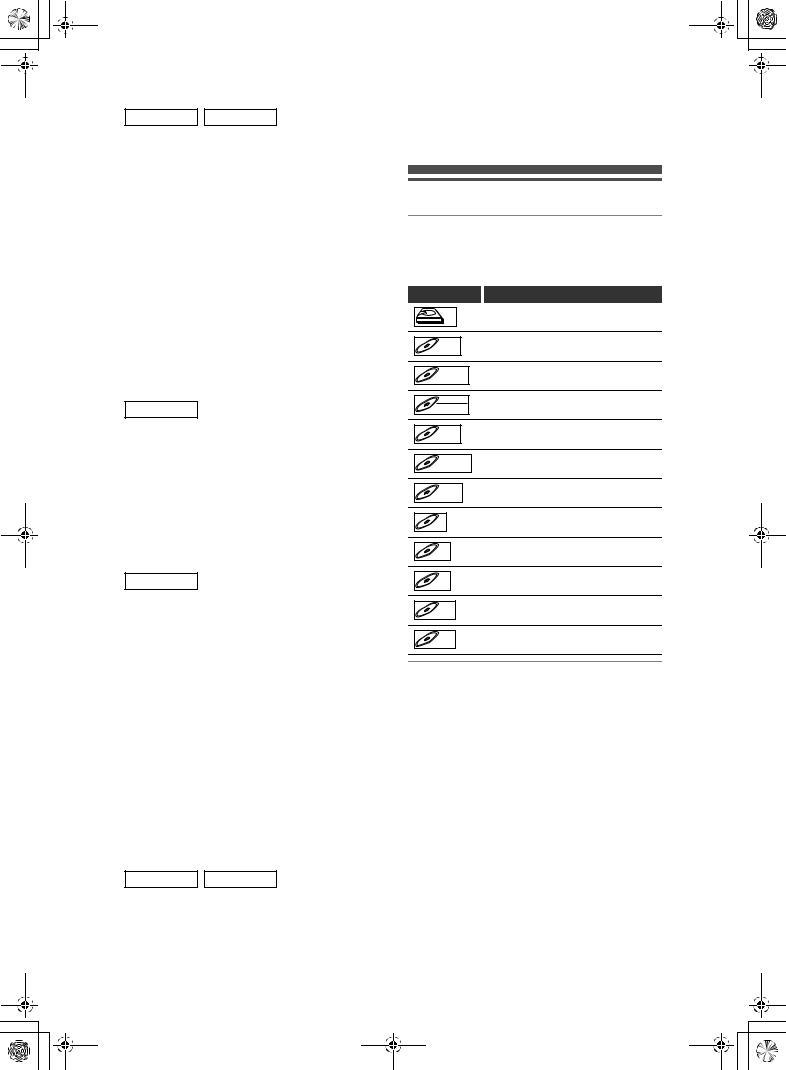
E2N7071FD_EN.book Page 8 Thursday, February 28, 2008 12:21 PM
Editing
HDD DVD
Adding or Deleting Chapter Marks Manually:
[E Pages 76 - 77]
You can add or delete chapter marks manually.
Creating Titles to a Playlist: [E Page 79] You can create a title to the Playlist.
Deleting Titles: [E Page 74]
You can delete titles which you do not need anymore.
Deleting a Scene of a Title: [E Pages 80 - 81] You can delete a specific scene of a title.
Editing title name: [E Pages 75 - 76]
You can name titles or change the title name.
Combining Titles: [E Page 79]
You can combine two titles into a single title.
Dividing Titles: [E Pages 78 - 79] You can divide a title into two new titles.
Protecting titles: [E Page 78]
To avoid accidental editing or erasing of titles, the protect function is useful when set to “ON” in the Original list.
DVD
Adding or Deleting chapter marks at once (Video mode DVD-RW only)
[E Page 77]
You can easily add chapter marks at every selected time interval or delete all chapter marks at once for easy editing.
Hiding chapters: [E Pages 77 - 78]
To keep others from playing back some chapters without permission, you can hide chapters.
Compatibility
DVD
Playing back discs recorded in Video mode in any regular DVD player: [E Page 57]
Discs recorded in Video mode can be played back in regular DVD players, including computer DVD drives compatible with DVD-Video playback. You will need to finalise the discs recorded in Video mode to play back in other DVD players.
Although DVD+RW / +R discs are playable in other units without finalisation in most cases, it is recommended to finalise in order to stabilise the performance.
*DVD-Video Format (Video mode) is a new format for recording on DVD-RW/-R discs that was approved by the DVD Forum in 2000. Adoption of this format is optional for manufactures of DVD playback devices and there are DVD-Video players, DVD-ROM drives and other DVD playback devices available that cannot play back DVD-RW/-R discs recorded in the DVD-Video Format.
Others
HDD DVD
Progressive scan system: [E Pages 21, 88] Unlike conventional interlace scanning, the progressive scan system provides less flickering and images in higher resolution than that of traditional television signals.
HDMI: [E Pages 21, 89 - 90]
(High-Definition Multimedia Interface)
You can enjoy clearer audio/video output when connecting this unit to a display device with an HDMI- compatible port.
Guide to the Owner’s Manual
Symbols Used in the Owner’s Manual
To show what recording mode or disc type applies to each function, the following symbols appear at the beginning of each operating item.
Symbol |
Description |
|
HDD |
Available to (internal) HDD |
|
|
||
DVD-V |
Available to DVD-Videos |
|
|
||
Video |
Available to DVD-RW discs in Video |
|
DVD-RW |
mode |
|
VR |
Available to DVD-RW discs in VR mode |
|
DVD-RW |
||
|
||
DVD-R |
Available to DVD-R discs in Video mode |
|
|
||
DVD+RW |
Available to DVD+RW discs |
|
|
||
DVD+R |
Available to DVD+R discs |
|
|
||
CD |
Available to Audio CDs |
|
|
||
VCD |
Available to Video CDs |
|
|
||
MP3 |
Available to CD-RW/-R discs with MP3 |
|
files |
||
JPEG |
Available to CD-RW/-R discs with JPEG |
|
files |
||
DivX® |
Available to DVD-RW/-R, DVD+RW/+R |
|
and CD-RW/-R discs with DivX® files |
Symbols for Tuner Setting
The following is the description for the symbols for tuner setting used in this manual.
ANALOG |
: Settings only for the Analogue |
|
mode |
|
|
DVB |
: Settings only for the DVB mode |
8 EN
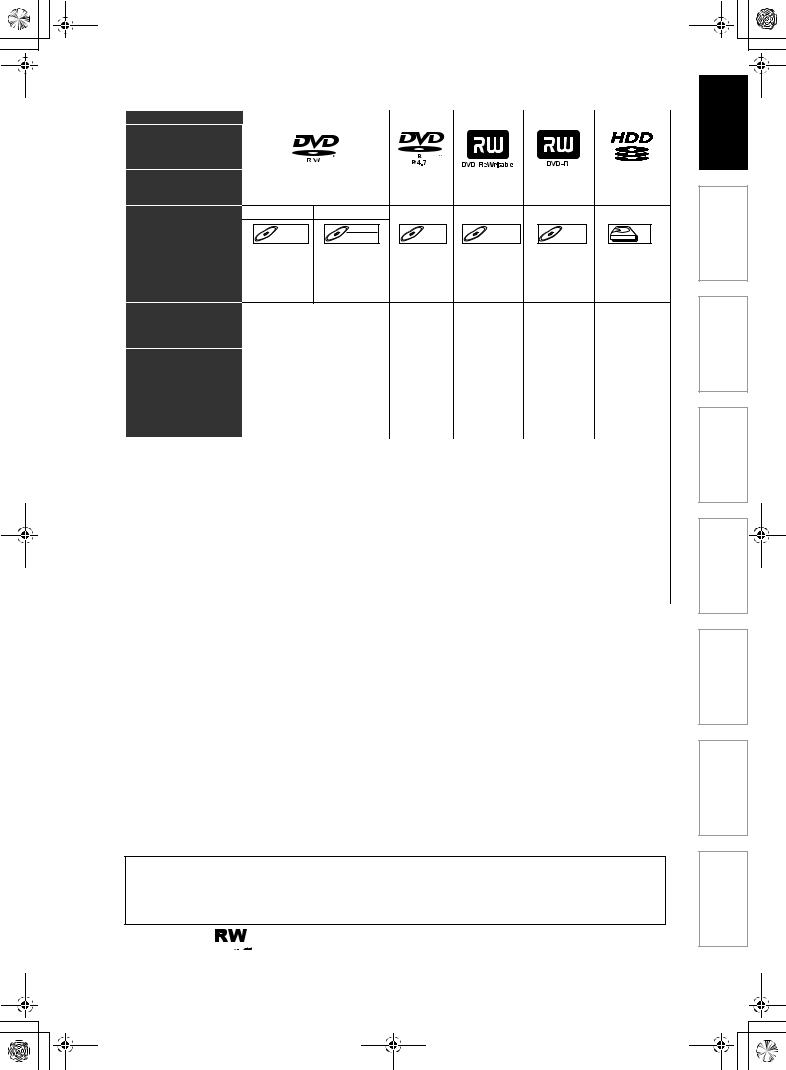
E2N7071FD_EN.book Page 9 Thursday, February 28, 2008 12:21 PM
|
|
Medias for Recording / Playing |
|
|
|
|
|
Disc Type |
|
|
|
|
|
|
|
DVD-RW |
DVD-R |
DVD+RW |
DVD+R |
HDD |
|||
Logo |
|
|
|
|
|
|
|
|
|
|
|
|
|
|
|
|
|
|
|
|
|
|
|
|
|
|
|
|
|
|
|
Format |
Can be formatted in VR or Video |
Automatically |
Automatically |
Automatically |
|
||
formatted in |
formatted in |
formatted in |
– |
||||
|
|
mode |
Video mode |
+VR mode |
+VR mode |
|
|
|
|
|
|
||||
|
Video Mode |
VR Mode |
|
|
|
|
|
Icon |
Video |
VR |
|
|
|
|
|
DVD-RW |
DVD-RW |
DVD-R |
DVD+RW |
DVD+R |
HDD |
||
|
|||||||
|
480 min |
480 min |
480 min |
480 min |
480 min |
267 hrs |
|
|
(RD-88DTKF) |
||||||
Maximum Record Time |
(12 cm) |
(12 cm) |
(12 cm) |
(12 cm) |
(12 cm) |
||
424 hrs |
|||||||
144 min |
144 min |
144 min |
144 min |
144 min |
|||
|
(RD-98DTKF) |
||||||
|
(8 cm) |
(8 cm) |
(8 cm) |
(8 cm) |
(8 cm) |
||
|
(with SLP mode) |
||||||
|
|
|
|
|
|
||
Recordable/Playable |
Ver. 1.1, 1.2 |
|
Ver. 2.0 |
|
|
|
|
|
Ver. 2.0/4× |
|
|
|
|||
Versions |
Ver. 1.1/2× CPRM compatible |
Ver. 2.0/8× |
1×-4× |
1×-16× |
– |
||
|
Ver. 1.2/4× CPRM compatible |
Ver. 2.0/16× |
|
|
|
||
|
|
|
|
|
|
||
|
|
Playable on |
|
|
|
Playable on |
Playable on |
Playable on |
|
|
|
|
|
|
|
|
most DVD |
DVD+RW |
|
|
|
||
|
|
most DVD |
Playable only on |
most DVD |
|
|
|
||||
|
|
players. |
compatible |
|
|
|
|||||
|
|
players. |
VR mode |
|
players. |
|
|
|
|||
|
Compatibility |
|
Finalisation |
players. |
|
|
|
||||
|
Finalisation |
compatible unit. |
Finalisation |
|
– |
||||||
|
necessary. |
Finalisation |
|
||||||||
|
|
necessary. |
Finalisation |
|
recommended. |
|
|
|
|||
|
|
|
(Title menu |
recommended. |
|
|
|
||||
|
|
(Title menu will |
recommended. |
(Title menu will |
|
|
|
||||
|
|
be created) |
|
|
|
will be |
(Title menu will |
be created) |
|
|
|
|
|
|
|
|
created) |
be created) |
|
|
|
||
|
|
|
|
|
|
|
|
|
|
||
|
Recording Features |
|
|
|
|
|
|
|
|
|
|
|
|
|
|
|
|
|
|
|
|
|
|
|
|
|
|
|
|
|
|
|
|
|
|
Features |
Record TV |
|
|
|
|
|
|
|
|
||
Programmes |
|
|
|||||||||
|
|
|
|
|
|
|
|
|
|
|
|
|
Reuse by Deleting |
|
|
|
|
|
|
|
|
||
Available |
the Current |
|
|
|
|
||||||
Contents |
|
|
|
|
|
|
|
|
|
|
|
|
|
|
|
|
|
|
|
|
|
|
|
|
Record 16:9 Size |
|
|
|
|
|
|
|
|
||
|
Pictures |
|
|
|
|
||||||
|
|
|
|
|
|
|
|
|
|
|
|
|
Record Copy-once |
|
* |
|
|
|
|
|
|
||
|
Programmes |
|
|
|
|
|
|
||||
|
|
|
|
|
|
|
|
|
|
|
|
|
Create Chapters at |
|
|
|
|
|
|
|
|
||
|
Fixed Intervals |
|
|
||||||||
|
(auto chapter) |
|
|
|
|
|
|
|
|
|
|
|
Editing Features |
|
|
|
|
|
|
|
|
|
|
|
|
Playlist Original |
|
|
|
Playlist |
|
Original |
|||
|
Scene Delete |
|
|
|
|
|
|
|
|
|
|
|
Edit Title Name |
|
|
|
|
|
|
|
|
|
|
|
Create Chapters |
|
|
|
|
|
|
|
|
|
|
|
Wherever You Like |
|
|
|
|
||||||
|
(chapter mark) |
|
|
|
|
|
|
|
|
|
|
|
Divide a Title |
|
|
|
|
|
|
|
|
|
|
|
Combine Titles |
|
|
|
|
|
|
|
|
|
|
|
Hide Chapters |
|
|
|
|
|
|
|
|
|
|
|
Delete a Title |
|
|
|
|
|
|
|
|
|
|
|
Deleting Selected |
|
|
|
|
|
|
|
|
|
|
|
Titles |
|
|
|
|
|
|
|
|
||
|
|
|
|
|
|
|
|
|
|
|
|
|
Create a Playlist |
|
|
|
|
|
|
|
|
|
|
|
Protect a Title |
|
|
|
|
|
|
|
|
|
|
: Available |
|
Gray: Not available |
|
|
|
|
|
||||
*CPRM compatible disc only.
Because of problems and errors that can occur during the creation of DVD and CD software and/or the manufacture of DVD and CD discs, Toshiba cannot guarantee that product will play every feature of every DVD bearing the DVD logo and/or every CD bearing the CD logo. As one of the creators of DVD technology, Toshiba DVD players are manufactured using the highest standards of quality, and as a result, such incompatibilities are rare.
DVD players with 







 are capable of playing DVD-RW recorded in VR mode.
are capable of playing DVD-RW recorded in VR mode.
EN 9
Recording Setup Basic Connections Introduction
Playback
Others Setup Function Editing
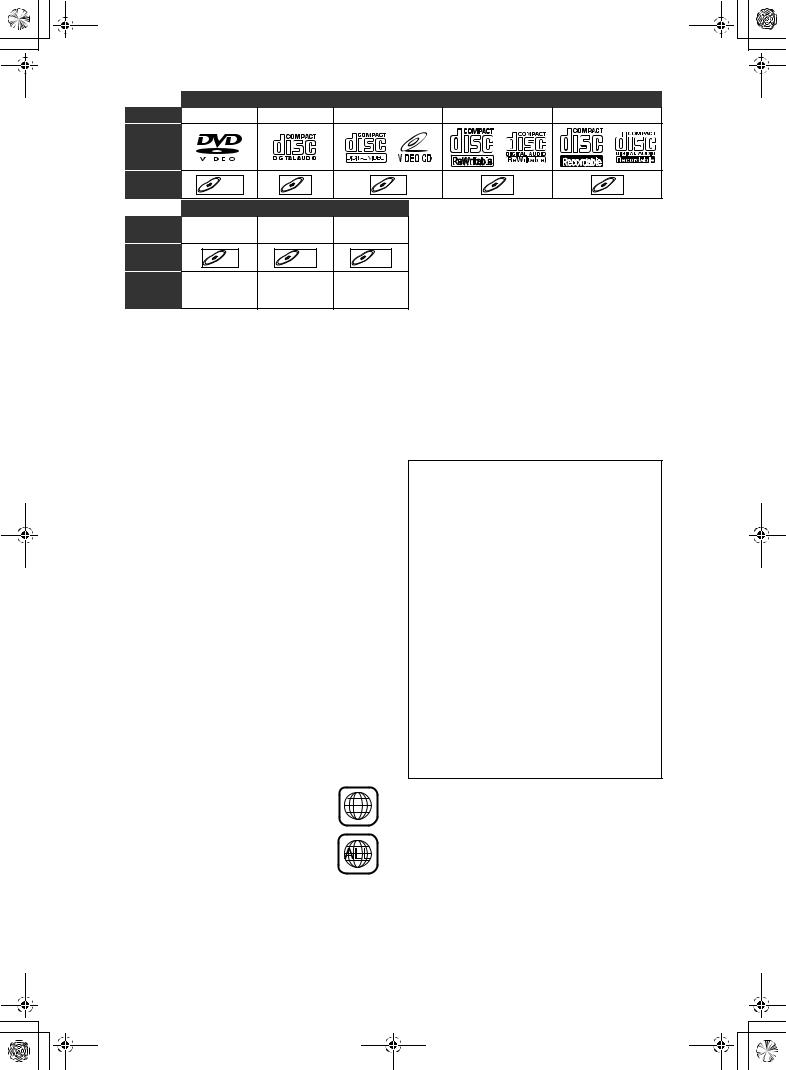
E2N7071FD_EN.book Page 10 Thursday, February 28, 2008 12:21 PM
Disc Type
Logo
Icon
Type of
title
Icon
Media
Discs for Playing
DVD-VIDEO |
|
CD-DA |
|
Video CD |
|
CD-RW |
|
CD-R |
||||||||
|
|
|
|
|
|
|
|
|
|
|
|
|
|
|
|
|
DVD-V |
CD |
VCD |
CD |
CD |
Files for Playing |
|
|
|
|
MP3 |
JPEG |
DivX® |
|
|
MP3 |
JPEG |
DivX® |
|
|
|
|
CD-RW/-R |
|
|
CD-RW/-R |
CD-RW/-R |
DVD-RW/-R |
|
|
|
|
DVD+RW/+R |
|
|
 is a trademark of DVD Format/Logo Licensing Corporation.
is a trademark of DVD Format/Logo Licensing Corporation.
•Official DivX® Certified product
•Plays all versions of DivX® video (including DivX® 6) with standard playback of DivX® media files.
•Discs containing the DivX® files with the DivX® GMC (Global Motion Compensation) playback feature, which is DivX® supplemental function, cannot be played back on this unit.
Unplayable Discs
The following discs will not play back on this unit.
• CD-ROM |
• Compact Disc-Interactive |
|
(CD-I) |
• Video Single Disc (VSD) • DVD-ROM |
|
• DVD-audio |
• Unfinalised disc |
•DVD contains MP3, Windows Media™ Audio or JPEG files
•DVD-RW/-R recorded in non compatible recording
format |
|
• Blu-ray Disc |
• HD DVD |
On the following disc, the sound may not be heard.
•Super audio CD - Only the sound on the CD layer can be heard. The sound on the high-density super audio CD layer cannot be heard.
Colour Systems
DVDs are recorded using different colour systems throughout the world. The most common colour system, used primarily in the U.K. and other EU countries, is PAL.
This unit uses the PAL system. However, it is also possible to play back DVDs using other colour systems, such as NTSC.
Region Codes |
|
|
This unit has been designed to play DVD |
|
|
with region 2. DVD must be labelled for ALL |
2 |
|
regions or for region 2 in order to play on the |
||
|
||
unit. You cannot play back DVD that are |
|
labelled for other regions. Look for the
symbols on the right on your DVD. If these region symbols do not appear on your DVD,
you cannot play back the DVD in this unit.
The number inside the globe refers to region of the world.
A DVD labelled for a specific region can only play back on the unit with the same region code.
Following discs are recommended for good recording quality and are proven to be compatible with this unit. However, depending on the media condition the unit may not read the disc properly.
Verbatim |
DVD+R 8x, DVD+RW 4x, DVD-R 8x, |
|
DVD-RW 2x |
JVC |
DVD-RW 4x |
Maxell |
DVD+R 4x/8x/16x, DVD-R 8x/16x |
SONY |
DVD+R 4x/8x/16x, DVD+RW 4x |
TDK |
DVD+R 4x/8x/16x |
Performance of any other discs are not guaranteed.
•Toshiba is not liable for any damage or loss caused directly or indirectly by the malfunction of this recorder, including, without limitation, any one of the following:
•Failure to record contents intended to be recorded by the consumer.
•Failure to edit contents as intended by the consumer.
•When a DVD-RW/-R, DVD+RW/+R disc created on this recorder is used (e.g., insertion, playback, recording or editing) in another DVD player, recorder or personal computer drive.
•When a DVD-RW/-R, DVD+RW/+R disc that is used in the manner described in the immediately preceding bullet point is used again in this recorder.
•When a DVD-RW/-R, DVD+RW/+R disc that was recorded in another DVD recorder, or in a personal computer drive is used in this recorder.
•Some functions may not work with personal computer discs.
•Discs recorded in this recorder may not operate as expected on other DVD players, recorders or personal computer drives.
10 EN

 E2N7071FD_EN.book Page 11 Thursday, February 28, 2008 12:21 PM
E2N7071FD_EN.book Page 11 Thursday, February 28, 2008 12:21 PM
Functional Overview
Front Panel
Introduction
1 |
2 |
I/yON/STANDBY |
DVD -RW/R +RW/R RECORDING |
3* |
4 |
5 |
6 |
|
7 |
|
|
OPEN/CLOSE |
HDD |
DVD |
STOP |
PLAY |
REC |
17 16 15 14* 13
8
1080p 1080i 720p 576p/480p
|
AV3 |
|
|
|
S-VIDEO |
VIDEO |
L |
R |
DV IN |
|
|
12 |
11 10 |
9 |
|
|
You can also turn on the unit by pressing these buttons. |
|
|
|
|
1 |
B ON\STANDBY button |
10 AUDIO input jacks (AV3) |
|
|
|
|
• Press to turn the unit on and off. |
• Use to connect external device with an RCA |
|||
2 |
Disc tray |
audio cable. |
|
|
|
11 VIDEO input jack (AV3) |
|
|
|||
|
• Place a disc when the disc tray is opened. |
|
|
||
3 |
A OPEN\CLOSE button* |
• Use to connect external device with an RCA |
|||
video cable. |
|
|
|||
|
• Press to open or close the disc tray. |
|
|
||
|
12 S-VIDEO input jack (AV3) |
|
|
||
4 |
Infrared sensor window |
|
|
||
• Use to connect the S-video output of external |
|||||
|
• Receive signals from your remote control so that |
||||
|
|
|
|
||
you can control the unit from a distance. |
device with an S-video cable. |
|
5HDD mode indicator
•Lights up in blue when the unit is in HDD mode.
6DVD mode indicator
•Lights up in green when the unit is in DVD mode.
7Display
•Refer to “Front Panel Display Guide” on page 19.
13I REC button
•Press once to start a recording. Press repeatedly to start one-touch timer recording.
14B PLAY button*
•Press to start or resume playback.
15C STOP button
•Press to stop playback or recording.
•Press to stop timer recording.
8 |
HDMI indicator |
16 |
DVD button |
|
• Press to select the DVD output mode. |
||
|
• Lights up and indicates the HDMI output mode |
|
|
|
17 |
HDD button |
|
|
when HDMI output is on. |
||
9 |
DV IN jack (AV4) |
|
• Press to select the HDD output mode. |
|
|
•Use to connect the DV output of external device with a DV cable.
Button names described in the Owner’s Manual
The instructions in this manual are described mainly with the operations using the remote control. Some operations can be carried out using the buttons on the front panel.
EN 11
Recording Setup Basic Connections
Playback
Others Setup Function Editing
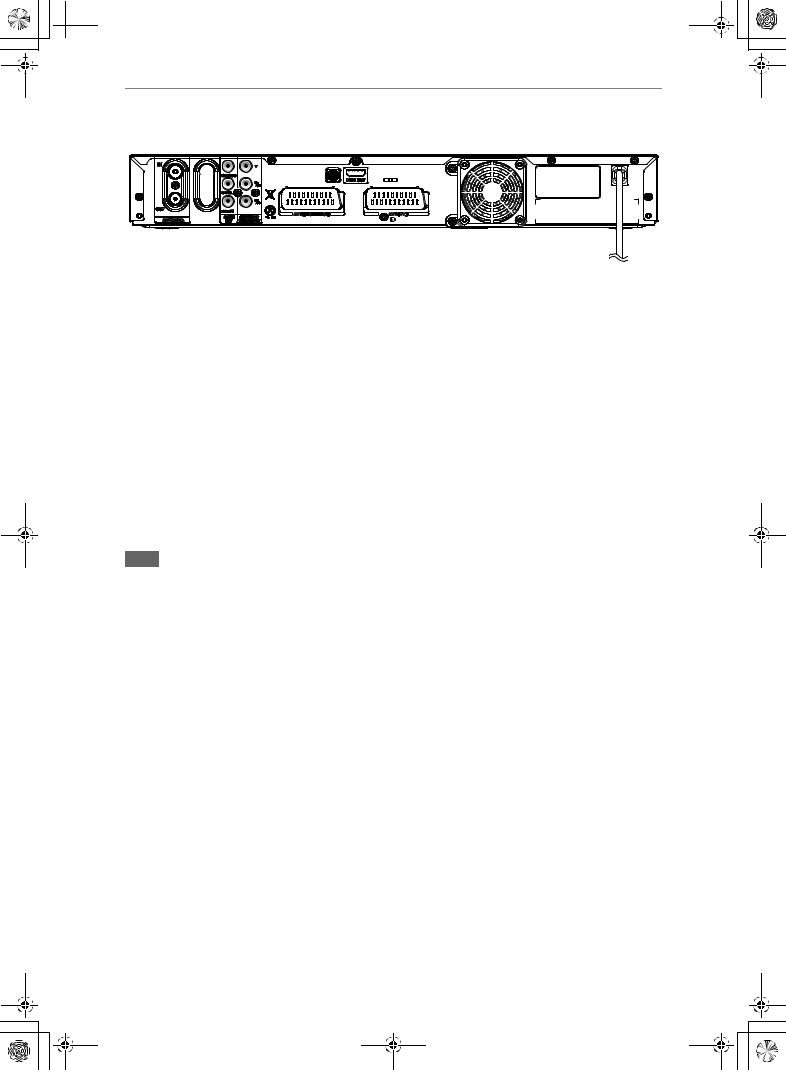
 E2N7071FD_EN.book Page 12 Thursday, February 28, 2008 12:21 PM
E2N7071FD_EN.book Page 12 Thursday, February 28, 2008 12:21 PM
Rear Panel
|
|
|
|
|
|
|
|
|
|
|
|
|
|
|
|
|
|
|
|
|
|
|
|
|
|
|
|
|
|
|
|
|
|
|
|
|
|
|
|
|
|
|
|
|
|
|
|
|
|
|
|
|
|
|
|
|
|
|
|
|
|
|
|
|
|
|
|
|
|
|
|
|
|
|
|
|
|
|
|
|
|
|
|
|
|
|
|
|
|
|
|
|
|
|
|
|
|
|
|
|
|
|
|
|
|
|
|
|
|
|
|
|
|
|
|
|
|
|
|
|
|
|
|
|
|
1 2 |
3 4 |
5 |
6 |
7 |
8 |
9 |
||||||||||||||
1ANTENNA IN
•Connect to an antenna or a cable.
2ANTENNA OUT
•Connect to the Aerial jack on your TV, cable box or direct broadcast system to output the signal received. Use the supplied RF cable.
3AUDIO OUT (ANALOG L\R) jacks
•Connect to the audio input jacks on your TV. Use a commercially available Audio cable.
4AUDIO OUT (DIGITAL COAXIAL) jack
•Connect to an amplifier with a digital input jack such as a Dolby Digital decoder, DTS decoder or MPEG decoder. Use a commercially available Coaxial cable.
6AV2 (DECODER) socket
•Connect to VCR, camcorder, or other AudioVideo equipment. Use a commercially available Scart cable.
7HDMI OUT jack
•Connect to a display with an HDMI compatible port. Use a commercially available HDMI cable.
8AV1 (TV) socket
•Connect to the Scart socket on your TV. Use a commercially available Scart cable.
9Mains cable
•Connect to a standard AC outlet.
5COMPONENT VIDEO OUTPUT jacks
•Connect to the component video input jacks on your TV. Use a commercially available Component Video cable.
Note
•Do not touch the inner pins of the jacks on the rear panel. Electrostatic discharge may cause permanent damage to the unit.
•This unit does not have an RF modulator.
12 EN
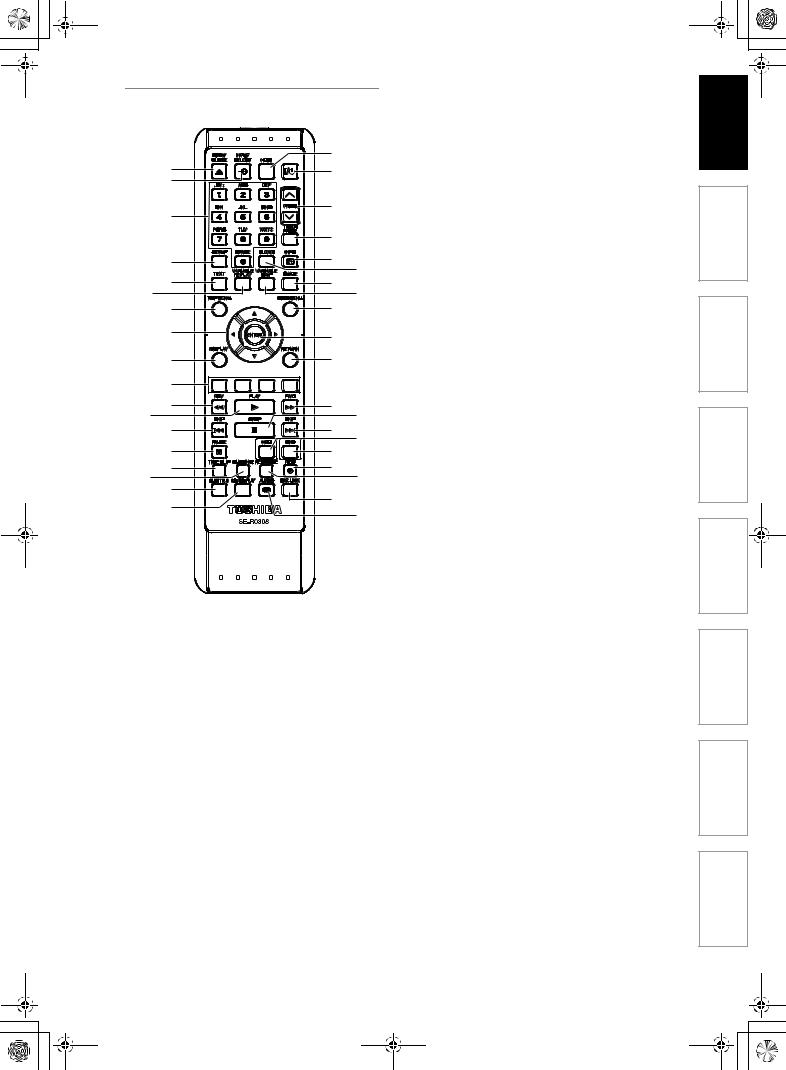
E2N7071FD_EN.book Page 13 Thursday, February 28, 2008 12:21 PM
Remote Control
1* |
19 |
|
|
20 |
|
||
2 |
|
|
|
3 |
21 |
|
|
|
|
||
|
22 |
|
|
4 |
23 |
24 |
|
5 |
25 |
||
26 |
|||
6 |
|||
7 |
27 |
|
|
8 |
28 |
|
|
|
|
||
9 |
29 |
|
|
10 |
|
|
|
12*11 |
30 |
31 |
|
13 |
32 |
33 |
|
14 |
34 |
|
|
1615 |
35 |
36 |
|
17 |
37 |
|
|
18 |
38 |
||
|
|||
|
|
( ) The unit can also be turned on by pressing these buttons.
) The unit can also be turned on by pressing these buttons.
1OPEN\CLOSE A button (DVD)*
•Press to open or close the disc tray.
2INPUT SELECT F button
•Press to select the DVB, analogue mode or appropriate input.
3Number buttons
•Press to select channel numbers.
•Press to select a title / chapter / track on the display.
•Press to enter values for settings in “Setup” menu.
•Press to enter the characters in edit function.
4SETUP button
•Press to display “Setup” menu in stop mode.
5TEXT button
•Press to switch Teletext on or off.
6VARIABLE REPLAY button
•Replays by the amount of time set in advance.
7TOP MENU button
•Press to display the Title list.
8Direction U \ D \ L \ P buttons
•Press to move the cursor and determine items or settings.
9DISPLAY button
•Press to display the On-Screen Display.
10RED/GREEN/YELLOW/BLUE button
•Press to follow the DVB instruction displayed onscreen.
11REV E button
•During playback, press to fast reverse.
•When playback is paused, press to reverse slowly.
12PLAY B button*
•Press to start or resume playback.
13SKIP H button
•During playback, press twice in quick successions to skip to the previous chapter or track.
•When playback is paused, press to play reverse step by step.
14PAUSE F button
•Press to pause playback or recording.
15TIME SLIP button (HDD)
•Press to virtually pause and resume the live TV broadcast.
16DUBBING button
•During playback, press to start dubbing right away.
•In stop mode, press to display “Dubbing” menu.
17SUBTITLE button
•During playing back DVD or watching a DVB channel which has subtitle information, press to call up the Subtitle menu.
181.3x\0.8x PLAY button
•During playback, press to playback in a slightly faster/slower speed while keeping the sound output.
19HDMI button
•Press to set the HDMI connector’s video signal output mode.
20B ON/STANDBY button
•Press to turn on or off the unit.
21PROG. G \ H buttons
•Press to change the channel up or down.
22TIMER PROG. button
•Press to display the timer programme setting menu.
23INFO C button
•Press to display the DVB programme information.
24CLEAR button
•Press to clear the password once entered.
•Press to cancel the programming for a disc.
•Press to clear the selecting marker number in the marker setup mode.
•Press to clear the programme once entered in the CD programme playback mode.
25GUIDE button
•Press to call up the EPG list in DVB mode.
26VARIABLE SKIP button
•Skips by the amount of time set in advance.
27DISC MENU button
•Press to display the Disc menu during playback.
•Press to change the Original and Playlist on the TV screen.
28ENTER button
•Press to acknowledge or approve a menu selection.
•While watching a DVB channel, press to display the “Quick select” menu.
29RETURN button
•Press to return to the previously displayed menu screen.
EN 13
Recording Setup Basic Connections Introduction
Playback
Others Setup Function Editing
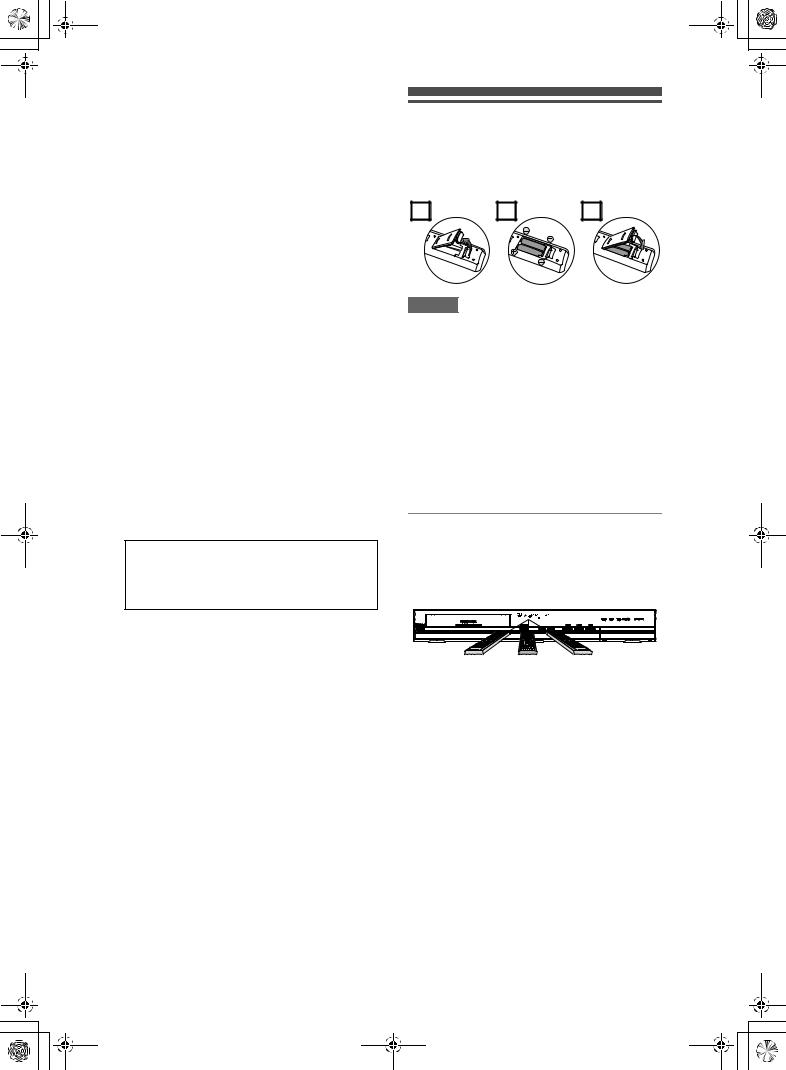
E2N7071FD_EN.book Page 14 Thursday, February 28, 2008 12:21 PM
30FWD D button
•When playback is paused, press to forward slowly.
•During playback, press to fast forward.
31STOP C button
•Press to stop playing back or recording.
32SKIP G button
•During playback, press to skip to the next chapter or track.
•When playback is paused, press to advance step by step.
33HDD button
•Press to select the HDD output mode.
34DVD button
•Press to select the DVD output mode.
35REC I button
•Press once to start a recording.
•Press repeatedly to start a One-touch Timer Recording.
36REC MODE button
•Press to switch the recording mode.
37SAT.LINK button (HDD)
•Press to activate the Satellite Link Timer Recording.
38AUDIO D button
•For analogue channels when receiving a bilingual broadcast, press to change the audio out setting to “Main”, “Sub” or “Main / Sub”.
•Press to change the bilingual audio source of an external equipment to “Main”, “Sub” or “Main / Sub”. (Available only when the “External Input Audio” in “Setup” menu is set to “Bilingual” in advance.)
•Press to select the sound mode for DVB channels.
•Press to display the audio menu during playback.
Button names described in the Owner’s Manual
The instructions in this manual are described mainly with the operations using the remote control. Some operations can be carried out using the buttons on the front panel.
Installing Batteries in the
Remote Control
Install two R6 (AA) batteries (supplied) into the remote control, carefully match with the polarity indicated inside the battery compartment.
1 |
2 |
3 |
Caution
•Incorrect use of batteries can result in hazards such as leakage and bursting.
•Do not mix new and old batteries together.
•Do not use different kinds of batteries together.
•Make sure that the plus (+) and minus (–) ends of each battery match the indications inside the battery compartment.
•Remove batteries if the equipment will not be used for a month or more.
•When disposing used batteries, please comply with governmental regulations or the public instructions for environmental protection that apply in your country or area.
•Do not recharge, short-circuit, heat, burn or disassemble batteries.
About the Remote Control
•Make sure there is no obstacle between the remote control and the remote control sensor on the unit.
•Use within the operating range and angle as shown.
HDD |
DVD |
|
HDD & DVDVIDEO RECORDER RD-88DT |
7 m (30°) 7 m 7 m (30°) Within
about 7 m
Remote control
• The maximum operable range as follows:
Line of sight: approximately 7 m Either side of centre: approximately 7 m within
30degrees
•Remote control operation may become unreliable if the remote control sensor of the unit is being exposed by the strong sunlight or fluorescent light.
•Remote controls for different devices can interfere with each other. Be careful when using remote controls for other equipment located close to the unit.
•Replace the batteries when the operating range of the remote control reduces.
14 EN
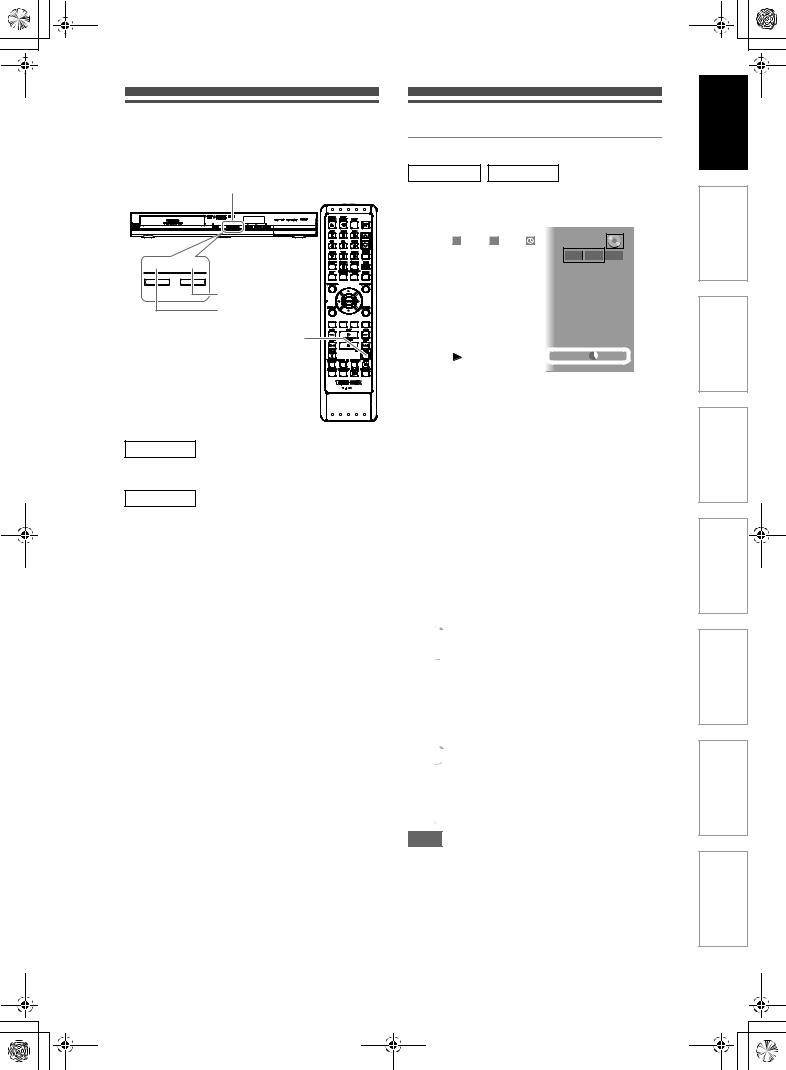
E2N7071FD_EN.book Page 15 Thursday, February 28, 2008 12:21 PM
Switching HDD / DVD mode
Because this unit is a combination of an HDD and a DVD recorder, you must select which component you want to operate first.
Device Select Indicators
HDD DVD
DVD indicator
HDD indicator
DVD button
HDD button 
HDD
Press [HDD] on the remote control or the front panel. (Verify that the HDD indicator is lit in blue.)
DVD
Press [DVD] on the remote control or the front panel. (Verify that the DVD indicator is lit in green.)
Guide to On-Screen Displays
DISPLAY Menu
HDD DVD
With a disc inserted into the unit, press [DISPLAY] to display the On-Screen Display. The menu shows information about what is recorded on the disc.
5 |
T |
1/ |
5 |
C |
1/ |
5 |
0:01:00 / 1:23:45 |
8 |
|
6 |
|
|
|
|
|
|
1 -RW |
VR |
ORG 2 |
|
|
|
|
|
|
|
3 |
901 TF1 |
|
7 |
4 DVD SP |
1:53 |
This is an example screen for explanation. Displayed items vary depending on the actual mode.
1Indicates a disc type and format mode. (DVD mode only)
2Indicates a type of titles for HDD and VR mode DVD-RW disc.
3Indicates a channel number, station name (analogue channel only) or selected external input mode.
4Indicates a media, recording mode and possible recording time left.
5Indicates the current title number/total number of titles, the current chapter number/total number of chapters, and time lapse of the current title playback/ total duration of the title.
6Each icon means:
 : Search
: Search
 : Audio
: Audio
 : Subtitle
: Subtitle
 : Angle
: Angle
 : Repeat
: Repeat
 : Marker
: Marker
 : Noise Reduction
: Noise Reduction
 : Zoom
: Zoom

 : Surround
: Surround
7Indicates an operation status.
8Indicates the component in use.
 : HDD
: HDD
 : DVD
: DVD
Note
•For some descriptions on this manual, only one disc type is indicated as an example.
EN 15
Recording Setup Basic Connections Introduction
Playback
Others Setup Function Editing
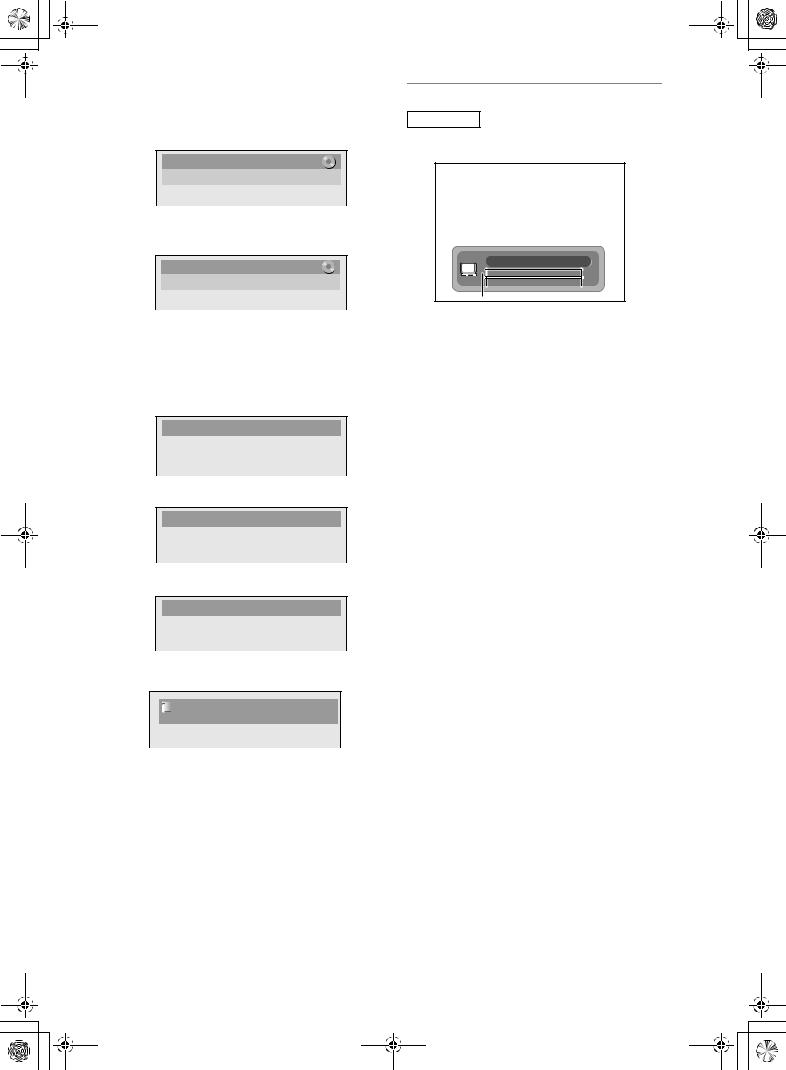
E2N7071FD_EN.book Page 16 Thursday, February 28, 2008 12:21 PM
Press [DISPLAY] while the On-Screen Display is displayed to display the following information.
<Title / File Name Information>
File name information
File Name
My File
(only when a CD with MP3/JPEG/DivX® files is in playback)
Title name information
Title Name
My Title
(only when DVD+RW/+R, VR mode DVD-RW/-R, unfinalised Video mode DVD-RW/-R disc or HDD is in playback)
<MP3 Tag Information>
(only when a CD with MP3 files is in playback)
Title name information
 Title Name
Title Name
Artist name information
 Artist Name
Artist Name
Album name information
 Album Name
Album Name
<HDMI Information> |
|
|
Video Info. : |
1 480p |
/ 2YCbCr |
Audio Info. : |
3 Bitstream |
|
(only for the images output through the HDMI output)
1Indicates the resolution of the HDMI output image.
2Indicates the HDMI video format.
3Indicates the HDMI audio format.
•“- - -” will be displayed, when it does not have any information.
INFO Menu
DVB
Press [INFO C] while viewing a DVB programme to display the programme information.
1  4 UKTV Gold
4 UKTV Gold  2
2
 10:00 -11:00 TV gossip show
10:00 -11:00 TV gossip show
11:00 -12:00 Cooking show
3 
 4
4
1Channel number
2Channel name
3Current programme information
4Next programme information
The window will automatically exit after 3 seconds, or press [INFO C] to exit.
16 EN
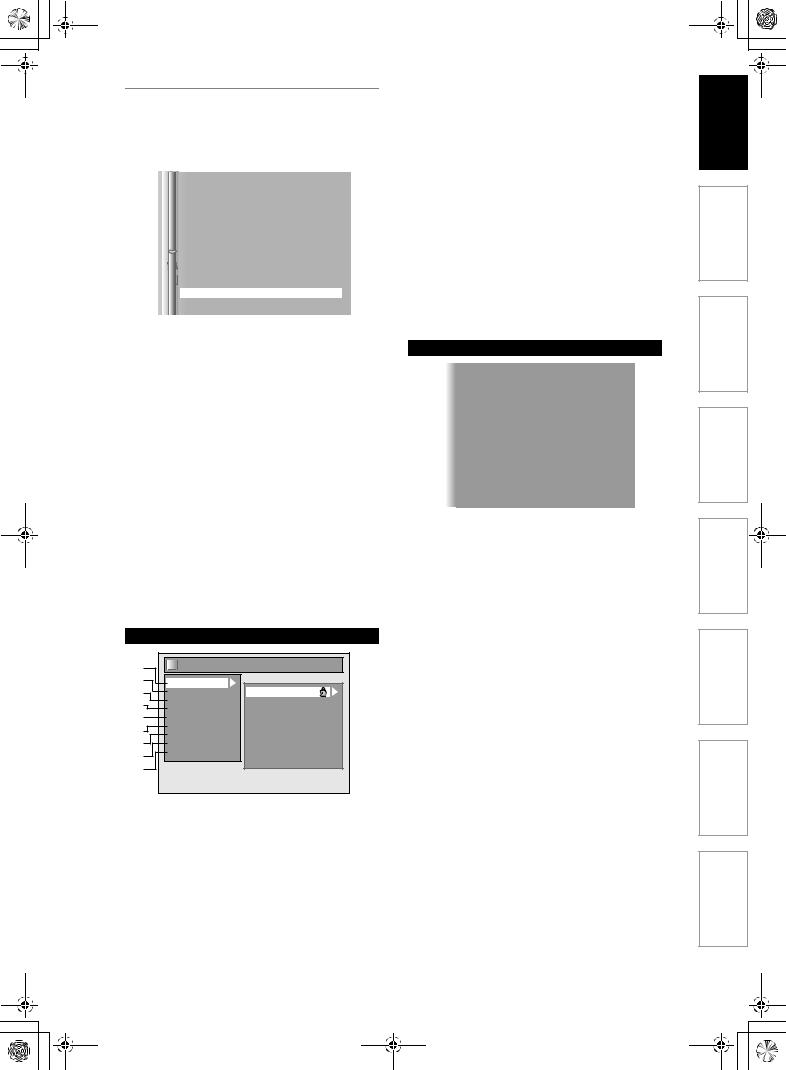
E2N7071FD_EN.book Page 17 Thursday, February 28, 2008 12:21 PM
Main Menu
Press [SETUP] to display the main menu. Then use [U \ D] to select a menu and press [ENTER] to display the sub menu. These menus provide entries to all main functions of the unit.
|
|
|
Setup |
|
|
|
|
|
|
1 |
|
|
General Setting |
|
|
|
|
||
2 |
|
|
Timer Programming |
|
3 |
|
|
Title List |
|
4 |
|
|
DVD Menu |
|
5 |
|
|
HDD Menu |
|
6 |
|
|
Dubbing |
|
7 |
|
|
DVB Menu |
|
8 |
|
|
CD Playback Mode |
|
|
|
|
|
|
|
|
|
|
|
|
|
|
|
|
1 General Setting:
To go to General Setting menu.
2 Timer Programming:
To programme a timer recording.
3 Title List:
To call up the title list.
4 DVD Menu:
To set up the DVD disc setting.
5 HDD Menu:
To set up the HDD setting.
6Dubbing:
•To dub the content of the HDD to DVD or vice versa.
•“Dubbing” is available only when a recordable disc is loaded.
7DVB Menu:
To set up the DVB setting.
8 CD Playback Mode:
To set up the CD playback setting.
•“CD Playback Mode” is available only when an audio CD, a video CD, a CD-RW/-R with MP3 / JPEG / DivX® files is inserted into the unit.
General Setting
1 |
General Setting |
|
2 |
Playback |
|
3 |
Display |
Parental Lock |
4 |
Video |
Audio Out |
Recording |
Disc Menu Language |
|
5 |
Clock |
Audio Language |
6 |
Channel |
Subtitle Language |
DivX |
Angle Icon |
|
7 |
HDMI |
Still Mode |
8 |
Reset All |
Variable Skip / Replay |
|
TV System |
|
9 |
|
|
1 |
Playback: |
|
To set up the unit to play discs as you prefer.
2 Display:
To set up the OSD screen as you prefer.
3 Video:
To set up the video setting.
4 Recording:
To set up the unit to record to discs as you prefer.
5 Clock:
To set up the clock of the unit as you need.
6 Channel:
To adjust the channel setting of the unit as you prefer.
7 DivX:
To set up the setting for the DivX® playback.
8 HDMI:
To set up the HDMI connection setting.
You cannot select if the HDMI cable is not connected.
9 Reset All:
To reset the setting to the factory default.
DVB Menu
|
|
|
|
|
|
|
|
|
1 |
|
|
|
DVB Menu |
|
|
||
|
|
|
|
|
|
|
|
|
2 |
|
Adult Lock |
|
|
|
|
||
|
Maturity Lock |
|
|
|
|
|||
3 |
|
Language |
|
|
||||
|
|
|
|
|||||
4 |
|
About |
|
|
|
|||
|
|
|
|
|
|
|
|
|
|
|
|
|
|
|
|
|
|
1 Adult Lock:
To set up the Pincode for “Adult Lock”.
2 Maturity Lock:
To set the age restriction for DVB programmes.
3 Language:
To set up the language for audio and subtitle.
4 About:
To check the current DVB system software version of this unit.
Recording Setup Basic Connections Introduction
Playback
Others Setup Function Editing
EN 17

E2N7071FD_EN.book Page 18 Thursday, February 28, 2008 12:21 PM
DVD Menu / CD Playback Mode / HDD Menu /
Dubbing
<DVD Menu menu>
1 |
|
|
|
|
|
|
DVD Menu |
|
||
|
|
|
|
|
|
|
||||
|
|
|
|
|
|
|
|
|
|
|
2 |
|
|
|
|
|
Format |
|
|
|
|
|
|
|
|
|
Finalise |
|
|
|
||
3 |
|
|
|
|
|
Disc Protect OFF ON |
|
|
||
|
|
|
|
|
|
|
|
|||
4 |
|
|
|
|
|
Delete All Playlists |
|
|
||
|
|
|
|
|
|
|
|
|
|
|
|
|
|
|
|
|
|
|
|
|
|
|
|
|
|
|
|
|
|
|
|
|
<CD Playback Mode menu>
 CD Playback Mode
CD Playback Mode
5
Random Play 6 Programme Play
Programme Play
7 PBC (Video CD only)
PBC (Video CD only)
Slide Show
8
<HDD Menu menu>
|
|
|
|
|
|
|
|
|
|
19 |
|
|
|
HDD Menu |
|||||
|
|
|
|
|
|
|
|
|
|
10 |
|
|
|
Delete All Titles |
|
|
|||
|
|
|
Delete All Unprotected Titles |
|
|
||||
11 |
|
|
|
Delete All Playlists |
|
||||
|
|
|
|
|
|
|
|
|
|
|
|
|
|
|
|
|
|
|
|
<Dubbing menu> |
|||||||||
|
|
|
|
|
|
|
|||
|
|
|
|
|
|
||||
12 |
|
|
|
Dubbing |
|||||
|
|
|
|
|
|
|
|
|
|
|
|
|
HDD |
DVD |
|
|
|
|
|
13 |
|
|
|
|
|
|
|
||
|
|
|
DVD |
HDD |
|
|
|
||
|
|
|
|
|
|
|
|
|
|
1Format (DVD-RW, DVD+RW only):
Allows you to format the disc.
2Finalise:
Allows you to finalise a disc containing recorded titles.
3 Disc Protect (VR mode DVD-RW, DVD+RW/+R disc only):
Allows you to protect a disc from accidental editing or recording.
4 Delete All Playlists (VR mode DVD-RW disc only):
Allows you to delete all Playlists.
5 Random Play:
Allows you to activate the random playback feature.
6 Programme Play (Audio CD/Video CD only):
Allows you to activate the programme playback feature.
7 PBC (Video CD only):
Allows you to select images or information on the menu screen by activating PBC (playback control) function.
8 Slide Show (JPEG files only):
Allows you to select the display time of the slide show mode.
9 Delete All Titles:
Allows you to delete all titles, including the protected titles in the HDD title list.
10 Delete All Unprotected Titles:
Allows you to delete all unprotected titles in the HDD title list.
11 Delete All Playlists:
Allows you to delete all Playlists for HDD.
12 HDD A DVD:
Allows you to dub from HDD to DVD.
13 DVD AHDD:
Allows you to dub from DVD to HDD.
18 EN
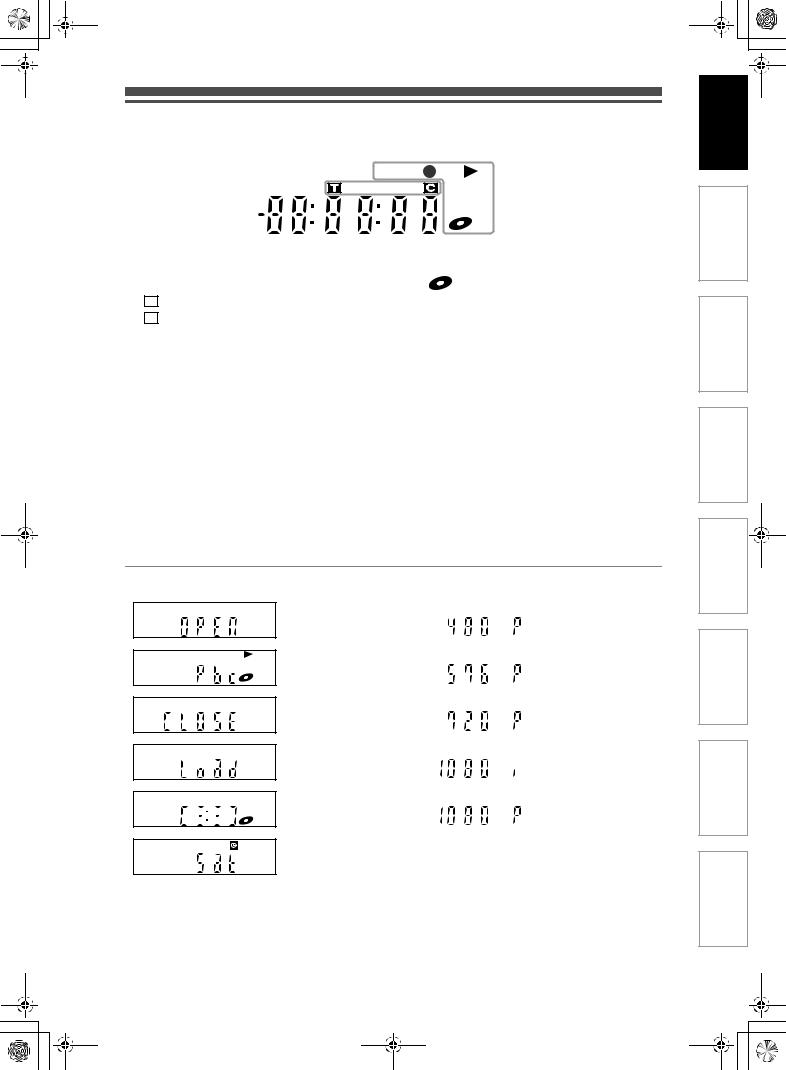
E2N7071FD_EN.book Page 19 Thursday, February 28, 2008 12:21 PM
Front Panel Display Guide
|
|
|
|
|
1 |
|
|
|
|
|
|
|
|
|
|||
|
|
|
|
|
|
|
|
|
|
|
|
|
|
|
|
|
2 |
|
|
|
|
|
|
|
|
|
|
|
|
|
|
|
|
|
|
|
|
|
|
|
|
|
|
|
|
|
|
DB |
|
|
|||
|
|
|
|
|
|
|
|
|
|
|
|
|
|||||
|
|
|
|
|
|
|
|
|
|
|
|
|
|
|
|||
|
|
|
|
|
|
|
|
|
|
|
|
|
|
|
|
|
|
|
|
|
|
|
|
|
|
|
|
|
|
|
|
|
|
|
|
|
|
|
|
|
|
|
|
|
|
|
|
|
|
|
|
||
|
|
|
|
|
3 |
|
|
|
|
|
|
|
|
|
|||
1 Title / Track and Chapter number |
|
|
|
|
: Appears when a disc is in this unit. |
||||||||||||
|
|
|
|
: |
Title / track number |
|
|
DB: Appears during dubbing. |
|||||||||
|
|
|
|
||||||||||||||
|
|
|
|
: |
Chapter number |
|
|
||||||||||
|
|
|
|
||||||||||||||
2 Current status of the unit |
3 |
Displays the following |
|||||||||||||||
|
|
• Playing back time |
|||||||||||||||
F: |
Appears when disc playback is paused. |
|
|
||||||||||||||
|
|
• Current title / chapter / track number |
|||||||||||||||
B: |
Appears during step by step playback. |
|
|
• Recording time / remaining time |
|||||||||||||
Appears when playing back an HDD or disc. |
|
|
• Clock |
||||||||||||||
F B: Appears during slow forward / reverse |
|
|
• Channel number |
||||||||||||||
|
|
|
: |
playback. |
|
|
• One-touch Timer Recording (OTR) remaining |
||||||||||
|
|
Appears when the timer programming or |
|
|
time |
||||||||||||
|
|
|
|
|
One-touch Timer Recording (OTR) is set |
|
|
• Selected HDMI output mode |
|||||||||
|
|
|
|
|
and is operating. |
|
|
|
|
|
|
|
|
|
|||
|
|
|
|
|
Appears when the unit goes into the |
|
|
|
|
|
|
|
|
|
|||
|
|
|
|
|
Satellite Link standby mode. |
|
|
|
|
|
|
|
|
|
|||
|
|
|
|
|
Flashes when timer programming was not |
|
|
|
|
|
|
|
|
|
|||
I: |
executed because of some error. |
|
|
|
|
|
|
|
|
|
|||||||
Appears when recording. |
|
|
|
|
|
|
|
|
|
||||||||
|
|
|
|
|
Flashes when recording being paused. |
|
|
|
|
|
|
|
|
|
|||
Display Messages
The disc tray is |
|
Appears when |
opening. |
|
HDMI output mode |
The PBC function |
|
(480p) is selected. |
|
Appears when |
|
|
||
of the Video CD is |
|
HDMI output mode |
activated. |
|
(576p) is selected. |
The disc tray is |
|
Appears when |
|
||
closing. |
|
HDMI output mode |
A disc is loading. |
|
(720p) is selected. |
|
Appears when |
|
|
||
|
|
HDMI output mode |
Data is being |
|
(1080i) is selected. |
|
Appears when |
|
|
||
recorded on a disc. |
|
HDMI output mode |
Appears when the |
|
(1080p) is selected. |
|
|
|
Satellite Link |
|
|
Recording is in |
|
|
standby. |
|
|
EN 19
Recording Setup Basic Connections Introduction
Playback
Others Setup Function Editing
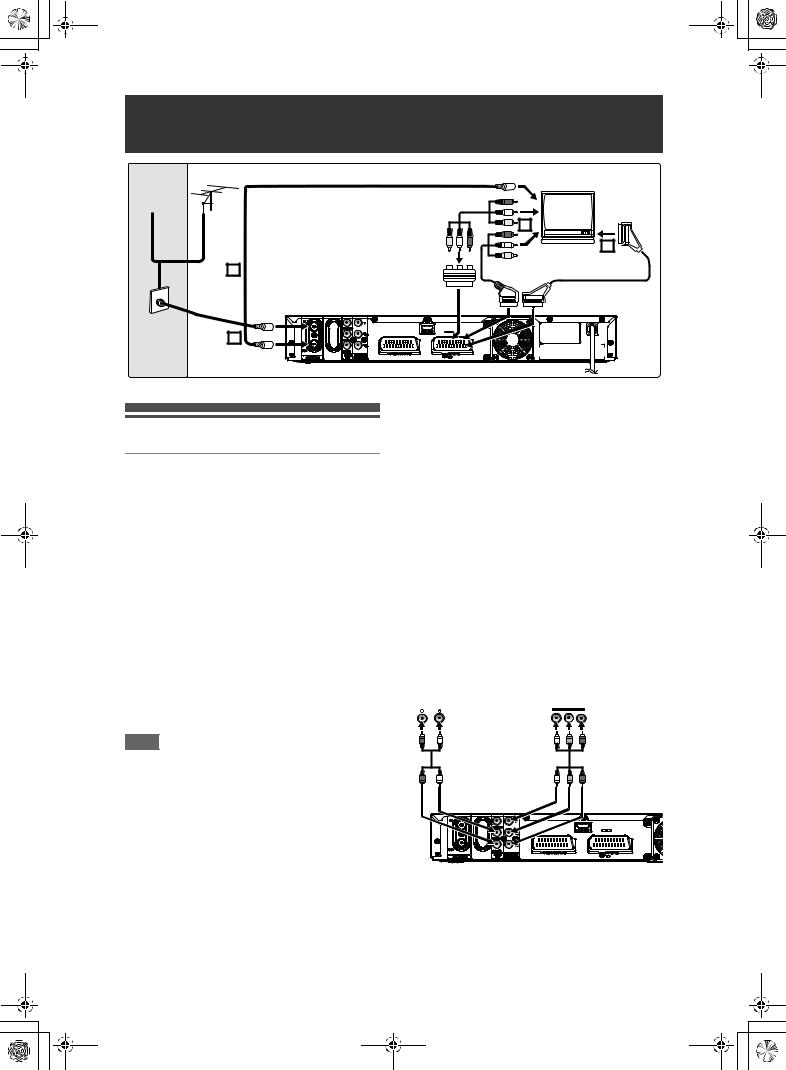
E2N7071FD_EN.book Page 20 Thursday, February 28, 2008 12:21 PM
Connections
Antenna |
To Aerial jack |
|
Cable
Signal
Audio/Video cable (not supplied)
3 |
or |
|
3 |
2 |
Scart adaptor |
Scart/RCA cable |
(not supplied) |
||
RF cable |
(not supplied) |
|
|
|
|
(supplied) |
|
|
|
|
Scart cable (not supplied) |
1 |
RF cable (not supplied)
Connections
Connecting to a TV
Connect the unit to a TV after considering the capabilities of your existing equipment.
Before installation, unplug your TV and this unit.
1 Connect the antenna or cable to the ANTENNA IN jack of this unit.
2 Connect the ANTENNA OUT jack of this unit to the Aerial jack of your TV. Use the supplied RF cable.
Using the Scart socket
3 Connect AV1 (TV) Scart socket of this unit to the Scart socket of your TV. Use a commercially available Scart cable.
Note
•If your TV does not have a Scart socket, use a commercially available Scart adaptor or Scart/RCA cable to connect.
•Connect this unit directly to the TV. If the AV cables are connected to a VCR, pictures may be distorted due to the copy protection system.
•When changing the “Video Out” setting (“SCART (RGB)”, “Component (Interlace)” or “Component (Progressive)”), connect to the corresponding jack on the TV. If the setting is
changed, for example, to “Component (Interlace)” or “Component (Progressive)” while the scart cable is connected to the TV, a distorted video signal may be output.
Using the COMPONENT VIDEO OUTPUT jacks and the AUDIO OUT (ANALOG L\R) jacks
If your TV has Component Video input jacks, use a Component Video cable and an Audio cable (to connect the AUDIO OUT (ANALOG L\R) jacks).
•Component connection provides the better quality picture.
3 Connect the COMPONENT VIDEO OUTPUT the jacks of this unit to the Component Video input jacks of your TV. Use a commercially available Component video cable.
4 Connect the AUDIO OUT (ANALOG L\R) jacks of this unit to the analogue Audio input jacks of your TV. Use a commercially available Audio cable.
AUDIO IN |
Component |
Video IN |
|
|
Y PB/CB PR/CR |
Audio cable |
Component |
(not supplied) |
Video Cable |
|
(not supplied) |
•After you have made the connections, set the “Video Out” setting. (See page 88.)
20 EN
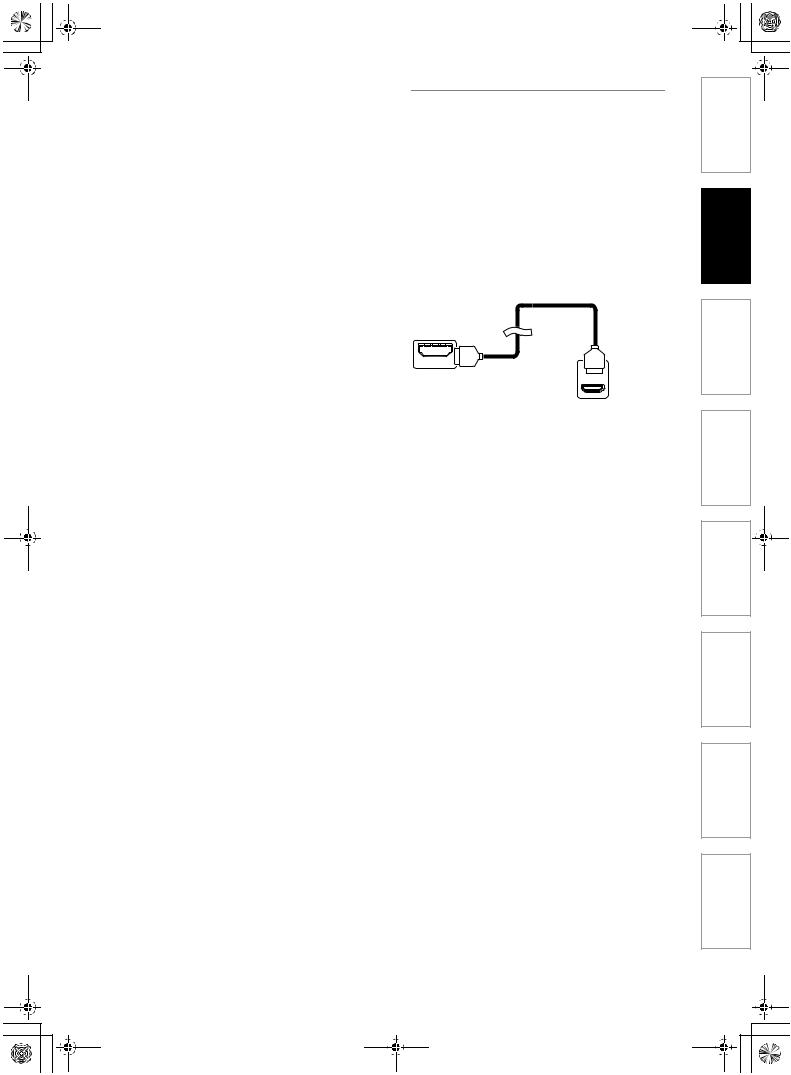
E2N7071FD_EN.book Page 21 Thursday, February 28, 2008 12:21 PM
Selecting Progressive Scan (576p/480p or Interlaced 576i/480i) Playback
•If your TV is compatible with progressive scanning (576p/480p), connect the TV to the COMPONENT VIDEO OUTPUT jacks of this unit and set “Video Out” setting to “Component (Progressive)” in “Setup” menu (See page 88.). Next, set your TV to the progressive scan mode.
•If your TV is not compatible with progressive scan, set “Video Out” setting to “Component (Interlace)”.
•Use a commercially available adaptor if the Video input jacks of your TVs or monitors are the BNC type.
•Only component and HDMI connections are compatible with the Progressive Scan.
Connecting to a TV with an HDMI Compatible Port
[HDMI CONNECTION]
A simple 1-cable connection with a device having an HDMI (high-definition multimedia interface) connector allows digital transfer of both digital video signals and multi-channel audio signals. This is the best method to connect this unit. It can minimise the deterioration of image quality.
Use the HDMI cable (commercially available) for connection.
Connect the HDMI output jack of this unit to the HDMI input jack of TV.
HDMI cable (not supplied)
To HDMI input jack
HDMI OUT
this unit HDMI IN
TV
Selecting HDMI mode
Press [HDMI] to select the HDMI output mode. The output mode changes as follows every time [HDMI] is pressed. 576p (PAL) / 480p (NTSC) J 720p J 1080i J 1080p (An HDMI mode that is not supported by the display device will be skipped.)
Actual Output Modes by Media
Audio recording format |
Dolby Digital / |
|
||
DTS / MPEG |
Actual output |
|||
of the disc |
|
|||
|
setting of this unit |
|
||
|
|
|
||
|
|
|
|
|
|
Dolby |
PCM |
2channel PCM |
|
|
Digital |
Stream |
Dolby Digital |
|
|
|
|
|
|
|
LPCM |
PCM |
2channel PCM |
|
|
|
|||
DVD-video |
Stream |
|||
|
|
|||
|
|
|
||
DTS |
ON |
DTS |
||
|
||||
|
|
|
||
|
OFF |
- |
||
|
|
|||
|
|
|
|
|
|
MPEG |
PCM |
2channel PCM |
|
|
|
|
||
|
Stream |
MPEG |
||
|
|
|||
|
|
|
|
|
|
Dolby |
PCM |
2channel PCM |
|
|
Digital |
Stream |
Dolby Digital |
|
|
|
|
|
|
DivX® |
MP3 |
PCM |
2channel PCM |
|
|
||||
Stream |
||||
|
|
|
||
|
|
|
|
|
|
MP2 |
PCM |
2channel PCM |
|
|
|
|
||
|
Stream |
MPEG |
||
|
|
|||
|
|
|
|
|
For Audio CD, Video CD and MP3 files, 2 channel PCM will be output regardless of the “Dolby Digital” setting.
If the connected device is not compatible with HDMI BITSTREAM, audio will be output as PCM even if you select “Stream” in “Dolby Digital” setting.
(See page 85.)
EN 21
Recording Setup Basic Connections Introduction
Playback
Others Setup Function Editing
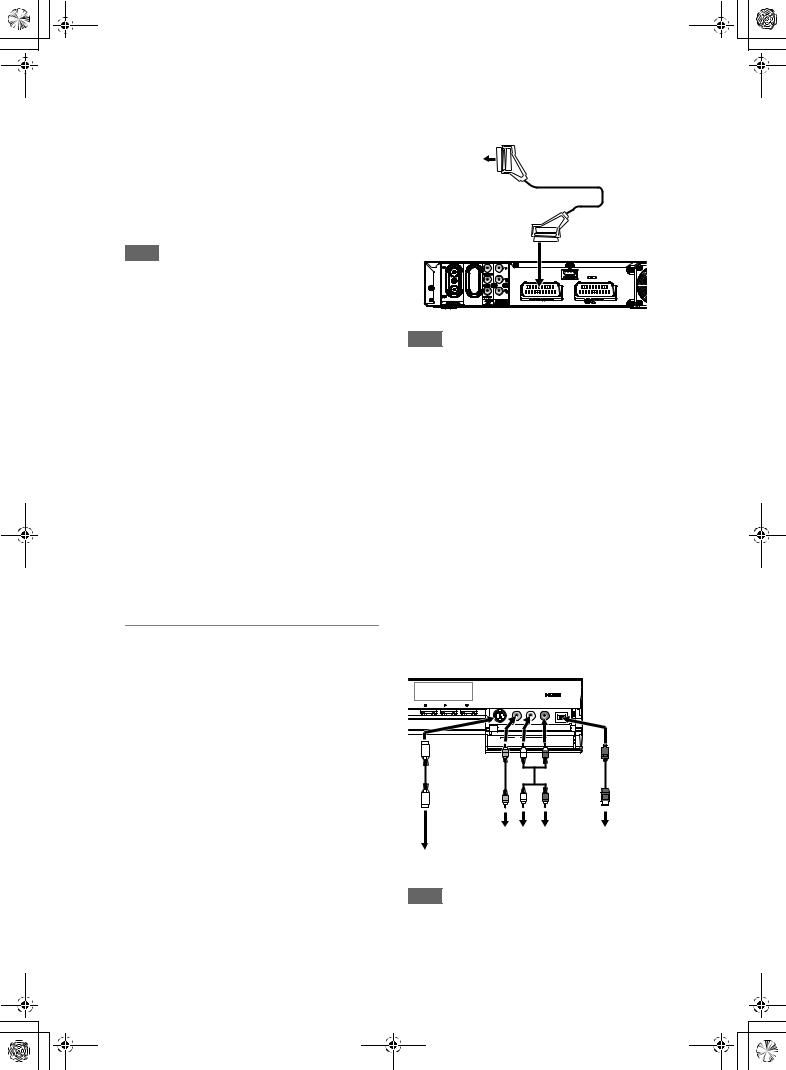
E2N7071FD_EN.book Page 22 Thursday, February 28, 2008 12:21 PM
Copyright protection system
To play back the digital video images of a DVD via an HDMI connection, it is necessary that both the player and the display device (or an AV amplifier) support a copyright protection system called HDCP (highbandwidth digital content protection system). HDCP is copy protection technology that comprises data encryption and authentication of the connected AV device. This unit supports HDCP. Please read the operating instructions of your display device (or AV amplifier) for more information.
* HDMI: High Definition Multimedia Interface
Note
•Because HDMI is an evolving technology, it is possible that some devices with an HDMI input may not operate properly with this unit.
•When using an HDCP-incompatible display device, the image will not be viewed properly.
•Among the devices that support HDMI, some devices can control other devices via the HDMI connector; however, this unit cannot be controlled by another device via the HDMI connector.
•The audio signals from the HDMI connector (including the sampling frequency, the number of channels and bit length) may be limited by the device that is connected.
•Among the monitors that support HDMI, some do not support audio output (for example, projectors). In connections with device such as this unit, audio signals are not output from the HDMI output connector.
•When this unit’s HDMI connector is connected to a DVI-D compatible monitor (HDCP compatible) with an HDMI-DVI conversion cable, the signals are output in digital RGB.
•If the connected equipment is not compatible with HDMI BITSTREAM, DTS sound will not be output.
•When the power failure occurs, or when you unplug the unit, some problems in the HDMI setting might occur.
Please check and set the HDMI setting again.
Connecting to an External Equipment
This unit has three input terminals which can be selected using [INPUT SELECT F] on the remote control, AV1 or AV2 on the rear panel and AV3 on the front panel. Be sure that all the units are switched off before making connections.
Recording from a DVD player, Satellite Box or other Audio-Video equipment with a Scart output socket (AV2)
AV output jack (Scart)
Scart cable (not supplied)
AV2 (DECODER)
Note
•When you record a TV programme from a Satellite Box, you must connect a Scart cable to AV2 (DECODER). (See page 49.)
•When AV2 is connected, the signal from the AV2 will be output automatically. If you want to monitor the signal from other input, you must press [DISPLAY] first. Then, select the desired input to monitor with
[INPUT SELECT F].
Recording from a camcorder or other Audio-Video equipment with no Scart output socket (AV3)
Connect to AUDIO input jacks on the front panel using an RCA audio cable.
If no S-Video input jack is available, connect to VIDEO input jack on the front panel using an RCA Video cable.
Change the setup when using S-VIDEO input jack. (See page 50.)
When connecting a DV-camcorder, use DV input jack of AV4 (Front) instead of S-VIDEO IN or VIDEO IN jack.
AV3 (Front)
1080p 1080i 720p 576p/480p
STOP |
PLAY |
REC |
|
AV3 |
|
|
|
|
S-VIDEO |
VIDEO |
L |
R |
DV IN |
|
S-Video cable |
|
|
|
Audio cable |
DV cable |
(not supplied) |
|
|
|
||
|
|
|
|
(not supplied) |
(4-pin) |
Video cable |
|
|
|
|
(not supplied) |
|
|
|
|
|
|
(not supplied) |
|
|
|
|
|
VIDEO OUT AUDIO OUT DV OUT
S-VIDEO OUT
Note
•When connecting an external device of monaural output to this unit, use AUDIO L jack of AV3.
22 EN
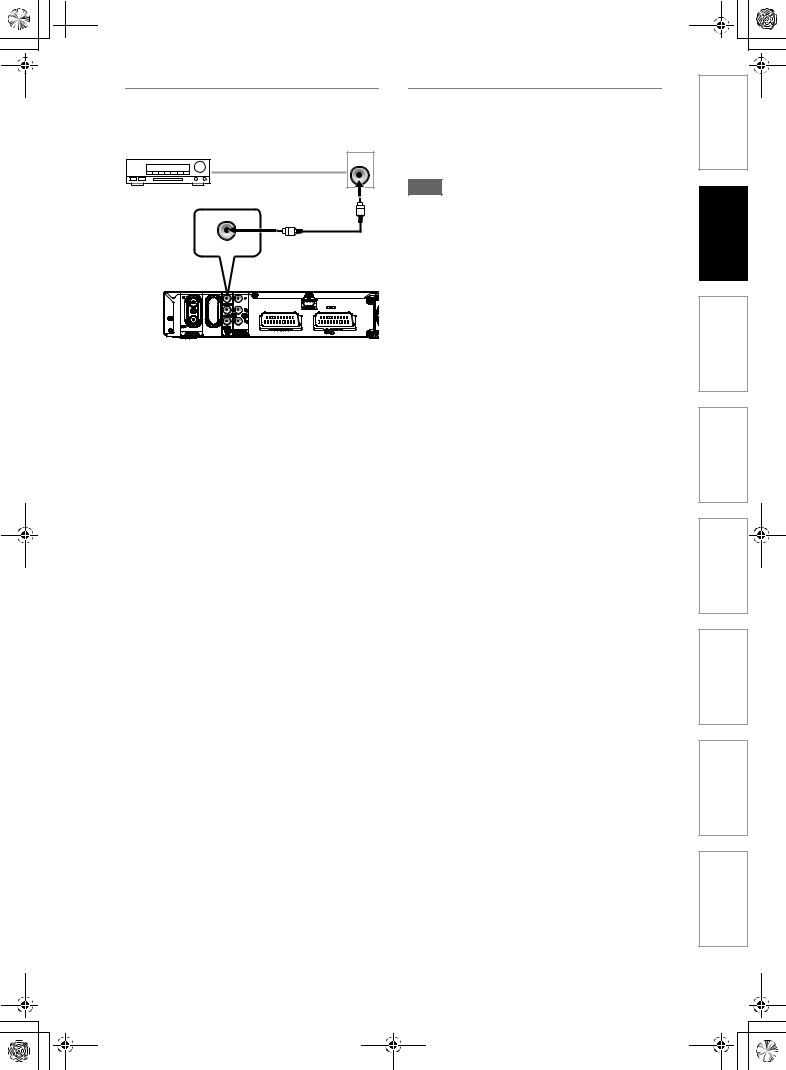
 E2N7071FD_EN.book Page 23 Thursday, February 28, 2008 12:21 PM
E2N7071FD_EN.book Page 23 Thursday, February 28, 2008 12:21 PM
Digital Audio for Better Sound Quality
Dolby Digital decoder, |
Digital audio |
DTS decoder or MPEG |
input jacks |
decoder, etc. |
|
|
COAXIAL |
|
Coaxial cable |
|
(not supplied) |
DIGITAL COAXIAL |
|
After You Have Completed
Connections
Switch the input selector on your TV to an appropriate external input channel. For details, refer to the Owner’s Manual of your TV.
Note
•Connect this unit directly to the TV. If the AV cables are connected to a VHS, pictures may be distorted due to the effects of the copy protection system.
The connections illustrated above are optional for better sound.
1 For clear digital sound quality, use the AUDIO OUT (DIGITAL COAXIAL) jack to connect your digital audio equipment.
If the audio format of the digital output does not match the capabilities of your receiver, the receiver will produce a strong, distorted sound or no sound at all.
Connecting a Dolby Digital™ decoder, DTS decoder or MPEG decoder
•Connecting multi-channel Dolby Digital decoder allows you to enjoy the Multi-channel Dolby Digital surround system as well as DTS decoder, Multichannel surround system.
•After connecting to a Dolby Digital decoder, set “Dolby Digital” to “Stream” in “Audio Out” menu. (See pages 84 - 85.)
•After connecting to a DTS decoder, set “DTS” to “ON” in “Audio Out” menu. (See pages 84 - 85.)
•After connecting to a MPEG decoder, set “MPEG” to “Stream” in “Audio Out” menu. (See pages 84 - 85.)
Connecting to an MD deck or DAT deck
•The audio source recorded in Dolby Digital Multichannel surround format cannot be recorded using an MD or DAT deck as a digital sound.
•If not connected to a Dolby Digital decoder, set “Dolby Digital” to “PCM” in “Audio Out” menu. Playing back a DVD using incorrect settings may generate noise distortion and damage speakers.
•Set “Dolby Digital” and “MPEG” to “PCM” and set “DTS” to “OFF” in “Audio Out” menu for connecting to an MD or DAT deck.
•You can use AUDIO OUT (ANALOG L\R) jacks for the connection of your audio system.
Recording Setup Basic Connections Introduction
Playback
Others Setup Function Editing
EN 23
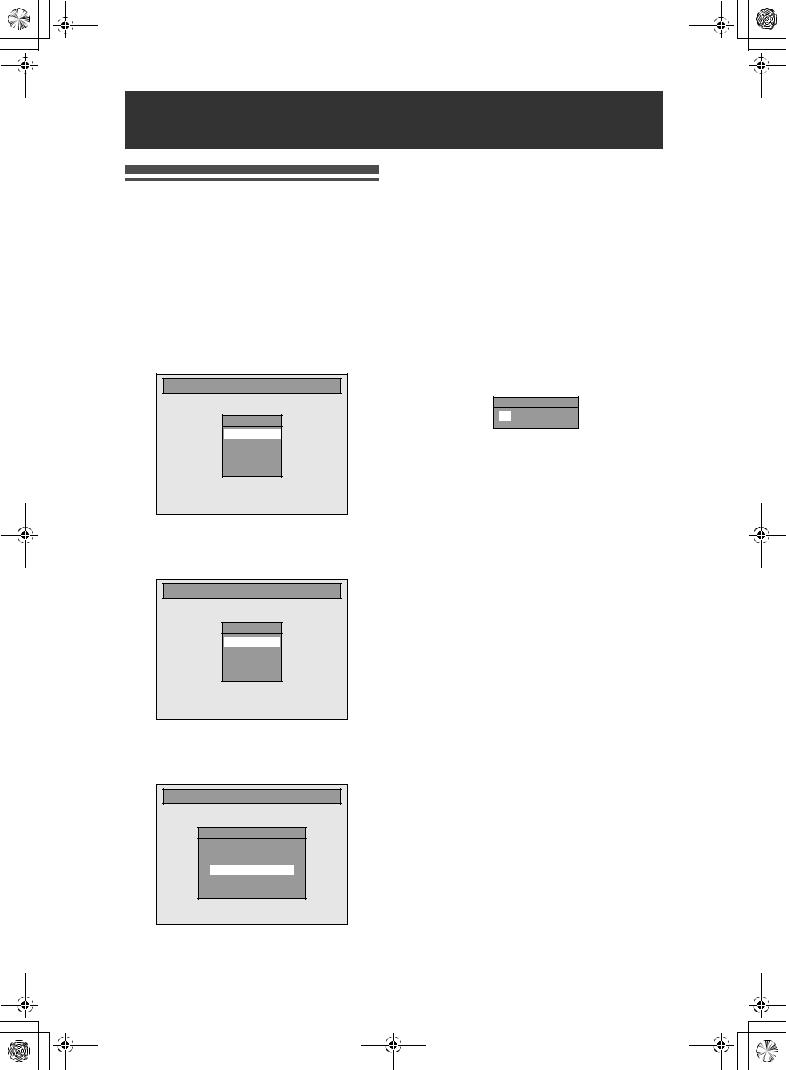
E2N7071FD_EN.book Page 24 Thursday, February 28, 2008 12:21 PM
Basic Setup
Initial Setting
When you turn on this unit for the first time, you need to follow these steps.
1 Press [B ON\STANDBY].
2 Turn the TV on. Select the input to which the unit is connected.
“Réglage initial” will automatically appear.
3 Select your desired language for the OSD using [U \ D]. Then press
[ENTER] to go to the next step.
Réglage initial
Langue Aff. écran
Français
English
Español
Deutsch
Italiano
4 Select your desired country to the channel plan using [U \ D]. Then press [ENTER] to go to the next step.
Initial Setting
Country
France
Spain
Germany
Italy
Switzerland
5 Select your desired channel preset type using [U \ D]. Then press
[ENTER].
Initial Setting
Auto Tuning
Make sure the antenna is connected to “ANTENNA IN” jack.
Digital tuning
Digital & Analog tuning
Analog tuning
The unit will start getting channels available in your area.
Digital tuning:
Only the DVB channels receivable in your area are automatically scanned and memorised.
Digital & Analog tuning:
Both analogue and DVB channels receivable in your area are scanned and memorised automatically.
Analog tuning:
Only the analogue channels receivable in your area are automatically scanned and memorised.
•If no channel has been memorised, the antenna confirmation display will appear. Press [ENTER] to start auto scanning again or press [RETURN] to cancel the initial settings.
6 After finishing channel setting, “Clock Setting” will appear. Then press [ENTER].
Clock Setting
01 / 01 / 2008 (TUE)
0 : 00
•If you want to adjust the clock, follow to step 5 on page 36 in “Manual Clock Setting”.
7 Press [ENTER] to exit.
24 EN
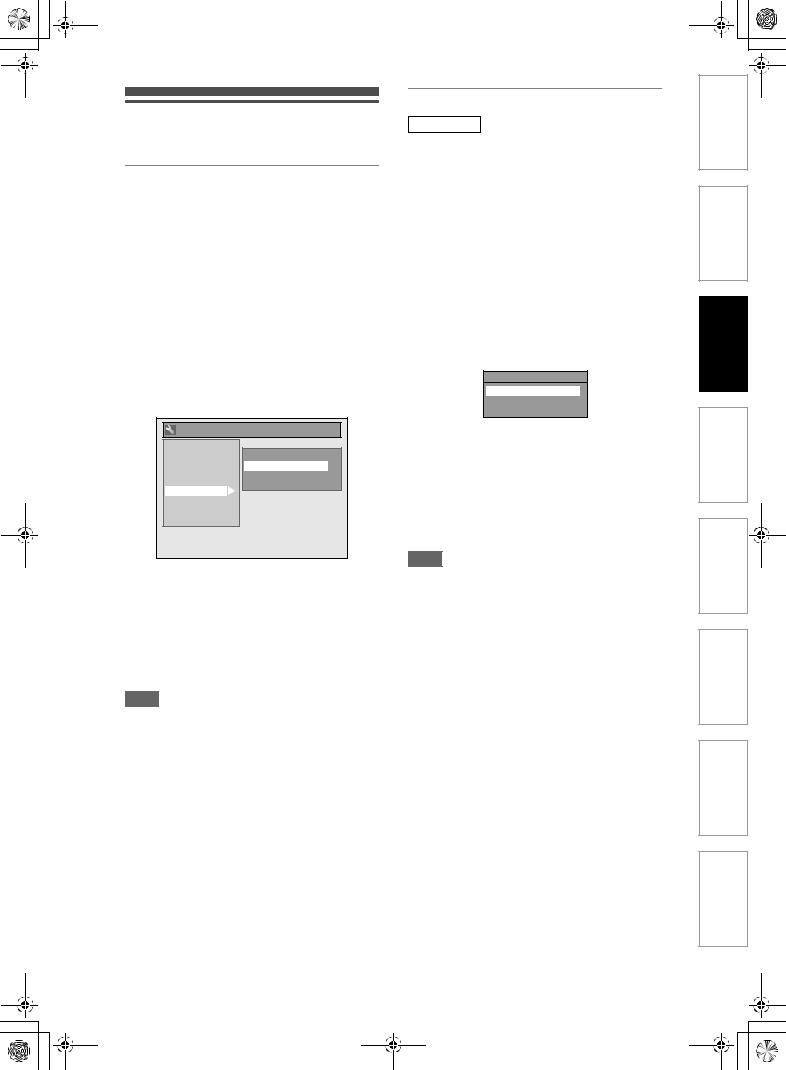
E2N7071FD_EN.book Page 25 Thursday, February 28, 2008 12:21 PM
Channel Setting
You can retune this unit or edit the channel setting with following methods.
Auto Tuning (DVB & ANALOG)
Programme the tuner to scan both analogue and DVB channels you can receive in your area.
1 In stop mode, press [SETUP]. Select “General Setting” using [U \ D], then press [ENTER].
General Setting menu will appear.
2 Select “Channel” using [U \ D], then press [ENTER].
3 Select “Auto Tuning (DVB & ANALOG)” using [U \ D], then press
[ENTER].
The unit will start storing channels available in your area.
General Setting |
|
Playback |
Country |
Display |
|
Video |
Auto Tuning (DVB & ANALOG) |
Recording |
DVB Channel Setup |
Clock |
ANALOG Channel Setup |
Channel |
|
DivX |
|
HDMI |
|
Reset All |
|
Wait for several minutes to finish channel storing.
•Analogue channels will be stored in channel 901-999 after it is scanned by this unit.
4 Press [SETUP] to exit.
You can select only the channels memorised in this unit by using [PROG. G \ H].
To cancel auto tuning
Press [RETURN] or [SETUP] during scanning.
Note
•The selection will be affected by how you receive TV channels in your local area.
•If the auto tuning is cancelled during scanning, some channels not yet tuned may not be received.
•You cannot change the channel when this unit is in any recording mode (normal recording, One-touch Timer Recording or timer recording).
Auto Tuning (ANALOG)
ANALOG
Programme the tuner to scan only the analogue channels you can receive in your area.
1 In stop mode, press [SETUP]. Select “General Setting” using [U \ D], then press [ENTER].
2 Select “Channel” using [U \ D], then press [ENTER].
3 Select “ANALOG Channel Setup” using [U \ D], then press [ENTER].
4 Select “Auto Tuning” using [U \ D], then press [ENTER].
The unit will start storing channels available in your area.
ANALOG Channel Setup
Auto Tuning
Manual Tuning
Move
Wait for several minutes to finish channel storing.
•Analogue channels will be stored in channel 901-999 after it is scanned by this unit.
5 Press [SETUP] to exit.
You can select only the channels memorised in this unit by using [PROG. G \ H].
To cancel auto tuning
Press [RETURN] or [SETUP] during scanning.
Note
•The selection will be affected by how you receive TV channels in your local area.
•If the auto tuning is cancelled during scanning, some channels not yet tuned may not be received.
•You cannot change the channel when this unit is in any recording mode (normal recording, One-touch Timer Recording or timer recording).
•Sorting of TV channels from 901 to 906 will be
performed automatically as follows.
901: TF1 |
902: F2 |
903: |
F3 |
904: CANAL+ |
905: F5/ARTE |
906: |
M6 |
Recording Setup Basic Connections Introduction
Playback
Others Setup Function Editing
EN 25
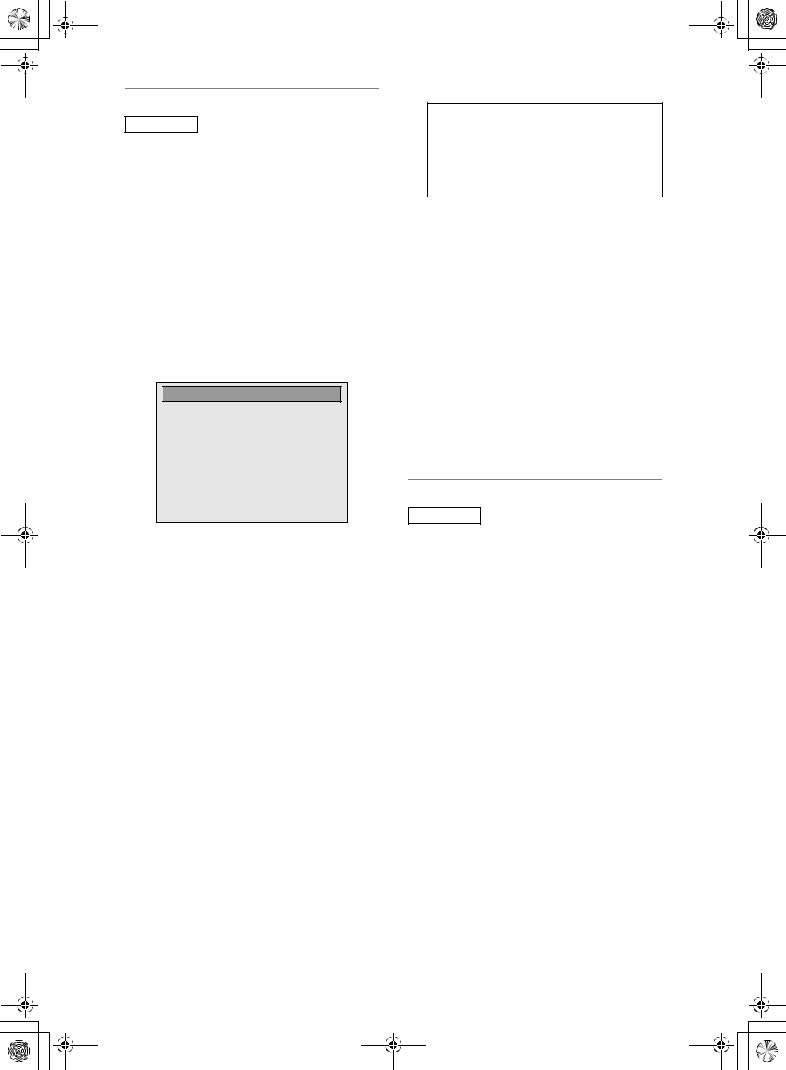
E2N7071FD_EN.book Page 26 Thursday, February 28, 2008 12:21 PM
Manual Tuning (ANALOG)
ANALOG
You can preset an analogue channel manually and individually.
1 In stop mode, press [SETUP]. Select “General Setting” using [U \ D], then press [ENTER].
2 Select “Channel” using [U \ D],
3 Select “ANALOG Channel Setup” using [U \ D], then press [ENTER].
4 Select “Manual Tuning” using [U \ D], then press [ENTER].
5 Select “Position” using [U \ D], then press [P].

 Manual Tuning
Manual Tuning
Position |
901 |
System |
L |
Channel |
1 |
Decoder |
OFF |
Skip |
ON |
|
|
6 Select the position number you want to use using [the Number buttons] or [U \ D], then press [L].
•You can select position number 901-999.
•With [the Number buttons], you only need to enter the last 2-digit numbers.
7 Select “System” using [U \ D], then press [P].
8 Select “L” or “BG” using [U \ D], then press [L].
•If your system is SECAM-L, select “L”.
•If your system is PAL-B/G, select “BG”.
9 Select “Channel” using [U \ D], then press [P].
10 Press [U \ D] to start scanning.
•The tuner will begin to search up or down automatically. When a channel is found, the unit will stop searching and the picture will appear on the TV screen.
•You can select a desired channel number using [the Number buttons]. Refer to the following Channel Plan table and press the three digits to select the channel number.
(To select channel 4, press [0] first and then press [0] and [4]. Or press [4] and then “– – 4” appears and wait for 2 seconds.)
•If this is the channel you want, press [L].
[L (SECAM-L)]
Channel Plan
CH Indication |
TV Channel |
|
01 |
– 10 |
F1 - F10 |
21 |
– 69 |
E21 – E69 |
74 |
– 86 |
B – Q |
90 – 106 |
S4 – S20 |
|
121 |
– 141 |
S21 – S41 |
[BG (PAL-B/G)] |
|
|
|
|
|
|
Channel Plan |
|
CH Indication |
TV Channel |
|
02 |
– 12 |
E2 - E12 |
13 |
– 20 |
A – H (only ITALY) |
21 |
– 69 |
E21 – E69 |
74 |
– 78 |
X, Y, Z, Z+1, Z+2 |
80 – 99, 100 |
S1 – S20, GAP |
|
121 |
– 141 |
S21 – S41 |
This unit can receive the Hyper and Oscar frequency bands.
•If “Skip” is set to “ON”, select “Skip” using [U \ D], then press [P]. Select “OFF” using [U \ D], then press [L].
•If you want to decode scrambled signals, select “Decoder” using [U \ D], then press [P]. Select “ON” using [U \ D], then press [L].
•To store another channel, repeat steps 5 to 10.
26 EN
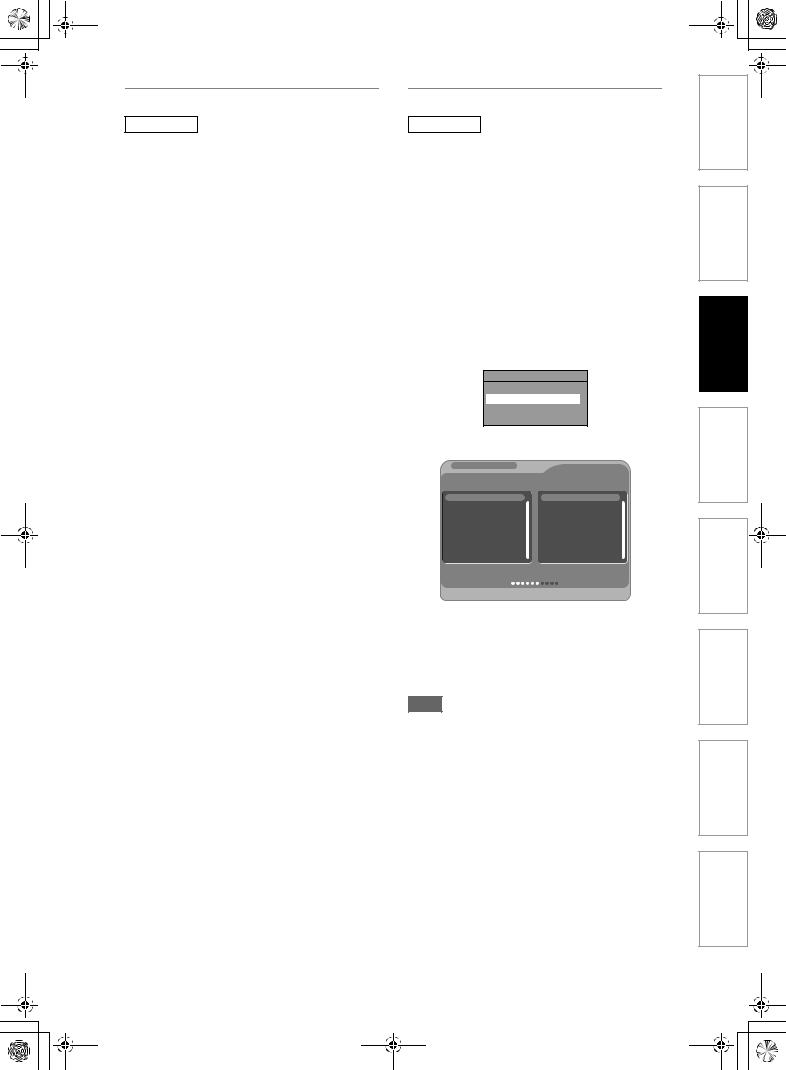
E2N7071FD_EN.book Page 27 Thursday, February 28, 2008 12:21 PM
Move
ANALOG
You can replace two channels.
1 In stop mode, press [SETUP]. Select “General Setting” using [U \ D], then press [ENTER].
2 Select “Channel” using [U \ D], then press [ENTER].
3 Select “ANALOG Channel Setup” using [U \ D], then press [ENTER].
4 Select “Move” using [U \ D], then press [ENTER].
5 Select the position number of which you want to change the channel using [U \ D], then press [ENTER].
You cannot select a position number where “– – –” appears next to the number, because “Skip” is set to “ON” for that position number.
6 Move the channel to another position number using [U \ D], then press
[ENTER].
• To move another channel, repeat steps 5 to 6.
7 Press [SETUP] to exit.
Auto Tuning (DVB)
DVB
You can programme the tuner to scan only the DVB channels that you can receive in your area.
1 In stop mode, press [SETUP]. Select “General Setting” using [U \ D], then press [ENTER].
2 Select “Channel” using [U \ D],
3 Select “DVB Channel Setup” using [U \ D], then press [ENTER].
4 Select “Auto Tuning” using [U \ D], then press [ENTER].
The unit will start storing channels available in your area.
DVB Channel Setup
Edit Channels
Auto Tuning
Manual Tuning
Signal Information
The tuner scans and memorises all the active DVB channels (TV / Radio) in your area.
|
Channel search |
|
|
S. No. TV channel |
S. No. Radio channel |
||
1 |
ITV1 |
700 |
BBC Radio 1 |
2 |
ITV2 |
701 |
BBC Radio 2 |
3 |
Channel |
702 |
Magic Radio |
4 |
E4 |
703 |
Classic FM |
Channel48 UHF |
690000kHz/8M |
||
|
Progress |
|
60% |
•Press [ENTER] after Auto Tuning is completed, then the lowest memorised DVB channel appears on the screen.
5 Press [SETUP] to exit.
You can use [PROG. G \ H] for the memorised DVB channels.
Note
•If you press [RETURN] during the scanning, the screen will return to the previous displayed menu, and Auto Tuning will be cancelled.
•If you press [SETUP] during the scanning, this operation will stop and the lowest memorised DVB channel will appear on the TV screen.
Recording Setup Basic Connections Introduction
Playback
Others Setup Function Editing
EN 27
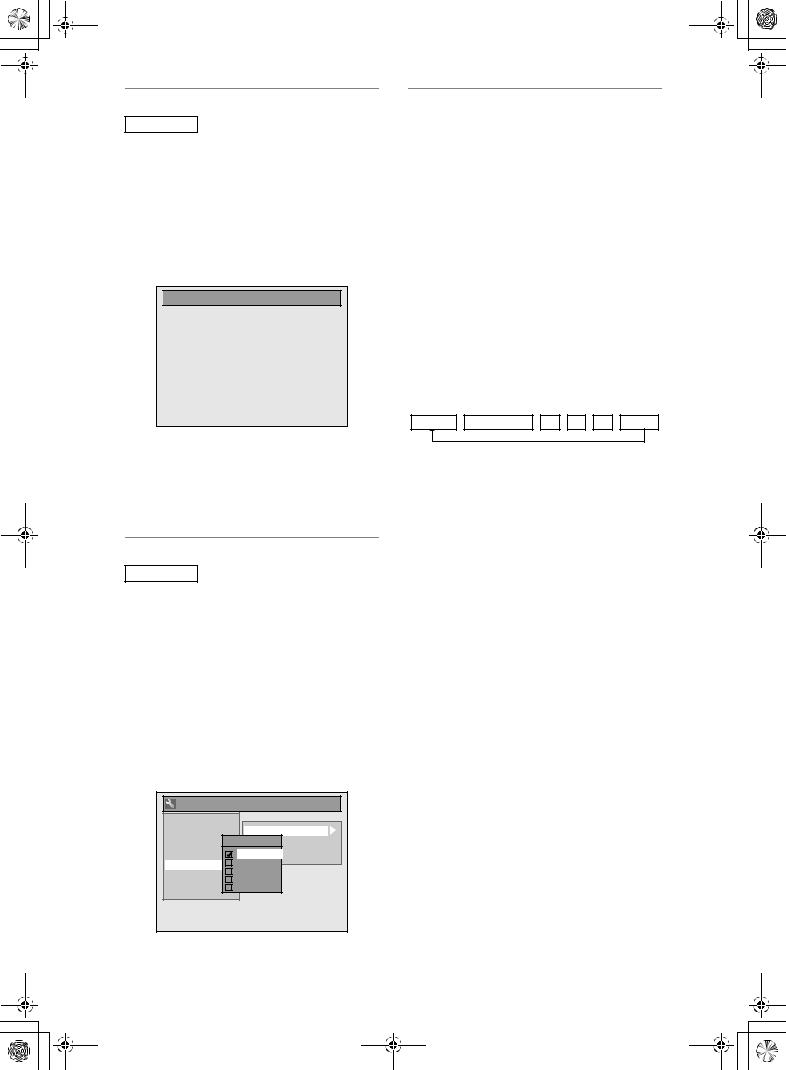
E2N7071FD_EN.book Page 28 Thursday, February 28, 2008 12:21 PM
Manual Tuning (DVB)
DVB
You can preset a DVB channel manually and individually.
1 Follow steps 1 to 3 in “Auto Tuning (DVB)” on page 27.
2 Select “Manual Tuning” using [U \ D], then press [ENTER].
3 Select your desired position number using [U \ D], then press [ENTER].

 Manual Tuning (DVB)
Manual Tuning (DVB)
Channel |
Auto |
|
|
•The tuner will begin to search up or down automatically. When a DVB channel is found, the unit will stop searching.
•When “Auto” is selected the unit will search for the channels which have not been stored in channels memory.
4 Press [SETUP] to activate the setting.
Country Setting
DVB
You can set the DVB channels to Channel Plan of each country.
1 In stop mode, press [SETUP]. Select “General Setting” using [U \ D], then press [ENTER].
2 Select “Channel” using [U \ D], then press [ENTER].
3 Select “Country” using [U \ D], then press [ENTER].
4 Select your desired country using [U \ D], then press [ENTER].
General Setting |
||
Playback |
France |
|
|
||
Display |
Country |
|
Video |
Auto Tuning (DVB & ANALOG) |
|
|
Country |
|
Recording |
DVB Channel Setup |
|
Clock |
France |
|
ANALOG Channel Setup |
||
Channel |
Spain |
|
Germany |
||
DivX |
||
Italy |
||
HDMI |
||
Switzerland |
||
Reset All |
||
|
||
5 Press [SETUP] to exit.
Select a Channel
You can select memorised channels by using
[PROG. G \ H].
You can select a channel using [PROG. G \ H] or directly enter the channel using
[the Number buttons].
Notes on using [the Number buttons]:
•For one or two-digit number channels, the channels will be identified 2 seconds after you press the channel number, or right after you press [ENTER]. For example, if you want to select channel 6, press [6] and wait for 2 seconds or press [ENTER]. You can only select channels 1 to 999.
•Analogue channels will be stored in channel 901999 and DVB channels will be stored in channel 1- 900 after it is scanned by this unit.
To switch DVB, analogue and external input (AV1/ AV2/AV3/DV(AV4)) mode.
You can switch between DVB, analogue and external input (AV1/AV2/AV3/DV(AV4)) mode by pressing [INPUT SELECT F] repeatedly. The mode changes as follows:
DVB mode Analogue mode AV1 AV2 AV3 DV(AV4)
•You can also switch the mode by using
[PROG. G \ H].
•You can select any DVB channels using
[the Number buttons] when you are in analogue or external input (AV1/AV2/AV3/DV(AV4)) mode.
•You can select any analogue channels using
[the Number buttons] when you are in DVB mode.
28 EN

E2N7071FD_EN.book Page 29 Thursday, February 28, 2008 12:21 PM
Quick Select
DVB
With “Quick select” menu, you can select your favourite DVB channel quickly. Refer to “Edit Group Lists” on page 30.
1 Press [ENTER] while watching a DVB channel.
• “Quick select” menu will appear.
Quick select
All
S. No. Channel name
1Moving picture 576i
2ITV1
3ITV2
4ITV3
5Channel
6E4
7More 4
2 Press [L \ P] to select your favourite group list. (“All”, “Group1” - “Group8”)
•“All” shows a list of all the memorised DVB channels.
•If the favourite group does not have any channels, the group will be skipped.
3 Select the DVB channel you want to watch using [U \ D], then press
[ENTER].
4 Press [RETURN] to exit.
Edit Channels (DVB)
DVB
With “Edit Channels” menu, you can see all the memorised DVB channels and sort them into the group lists (“Quick select”) or set the viewer limitation (“Adult Lock”), etc.
1 Follow steps 1 to 3 in “Auto Tuning (DVB)” on page 27.
2 Select “Edit Channels” using [U \ D], then press [ENTER].
• “Edit Channels” menu will appear.
|
|
|
|
Edit Channels |
|
|
|
|
||||
|
|
S. No. |
Channel name |
Fav Skip Lock Del |
|
|
|
|||||
|
|
|
1 |
|
Moving picture 576i |
|
1 |
|
|
|
||
1 |
|
|
2 |
|
ITV1 |
|
|
|
|
|
||
|
|
|
3 |
|
ITV2 |
|
|
|
|
4 |
||
|
|
|
|
|
|
|
|
|
||||
|
|
|
4 |
|
ITV3 |
|
|
|
|
|||
|
|
|
|
|||||||||
|
|
|
5 |
|
Channel |
|
4 |
|
|
|
||
|
|
|
6 |
|
E4 |
|
4 |
|
|
|
||
2 |
|
|
|
|
|
|
|
|
|
|
|
3 |
|
|
|
|
|
|
|
|
|
|
|
||
|
France |
|
Crystal Palac |
562000kHz/8M |
|
|
||||||
|
|
|
|
|
||||||||
|
|
|
||||||||||
1Channel numbers
2Channel names
3Channel information
4Channel setting
3 Press [SETUP] to exit.
Note
•Press [INFO C] to display the using guide. You can see each explanation of the buttons which can be used in “Edit Channels” menu. Press [RETURN] to return to “Edit Channels” menu.
Recording Setup Basic Connections Introduction
Playback
Others Setup Function Editing
EN 29
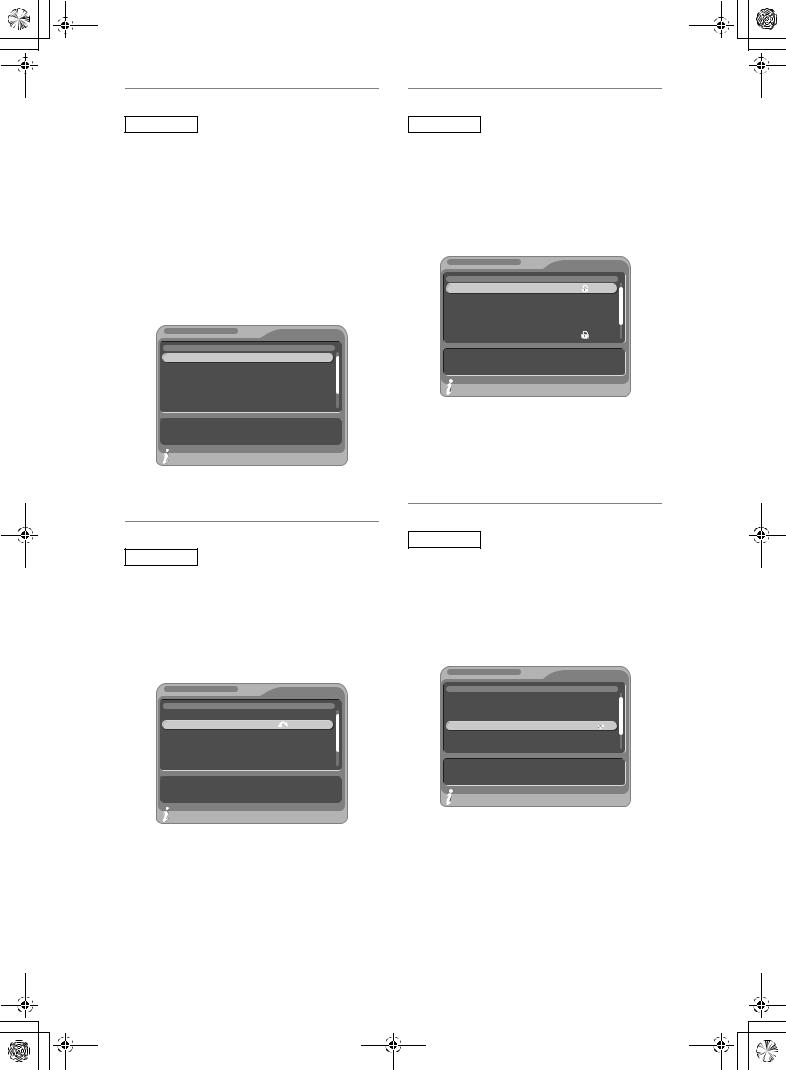
E2N7071FD_EN.book Page 30 Thursday, February 28, 2008 12:21 PM
Edit Group Lists
DVB
You can sort each DVB channel into 8 different favourite group lists (“Group1” -“Group8”). With “Quick select” menu, you can select your favourite DVB channel quickly. Refer to “Quick Select” on page 29.
1 Follow steps 1 to 2 in “Edit Channels (DVB)” on page 29.
2 Select the DVB channel you want to add to the favourite group list using [U \ D], then select the number of the favourite group list you want to add to using [the Number buttons] ([1] - [8]).
Edit Channels |
|
|
S. No. |
Channel name |
Fav Skip Lock Del |
1 |
Moving picture 576i |
1 |
2ITV1
3ITV2
4ITV3
5 |
Channel |
4 |
6 |
E4 |
4 |
France |
Crystal Palac |
562000kHz/8M |
•The number you selected will appear.
•Press [0] to cancel from the favourite group list.
3 Press [SETUP] to exit.
Skip Channels
DVB
You can set the unit to skip the unwanted DVB channels when you use [PROG. G \ H].
1 Follow steps 1 to 2 in “Edit Channels (DVB)” on page 29.
2 Select the DVB channel you want to skip using [U \ D], then press
[GREEN].
Edit Channels |
|
|
S. No. |
Channel name |
Fav Skip Lock Del |
1 |
Moving picture 576i |
1 |
2 |
ITV1 |
|
3ITV2
4ITV3
5 |
Channel |
4 |
6 |
E4 |
4 |
France |
Crystal Palac |
562000kHz/8M |
•“ ” will appear.
” will appear.
•Press [GREEN] to cancel. “ ” will disappear.
” will disappear.
3 Press [SETUP] to exit.
Adult Lock
DVB
You can set the unit to limit the access to the DVB channels.
1 Follow steps 1 to 2 in “Edit Channels (DVB)” on page 29.
2 Select the DVB channel you want to limit the access to using [U \ D], then press [YELLOW].
Edit Channels
S. No. Channel name |
Fav Skip Lock Del |
1 Moving picture 576i
2ITV1
3ITV2
4ITV3
5 |
Channel |
4 |
6 |
E4 |
4 |
France |
Crystal Palac |
562000kHz/8M |
•“ ” will appear.
” will appear.
•Press [YELLOW] to cancel. “ ” will disappear.
” will disappear.
3 Press [SETUP] to exit.
•Once you turn off the unit, Pincode will be required to view the locked channels.
•To set the Pincode, refer to “Pincode Setting for Adult Lock” on page 34.
Delete Channels
DVB
You can delete the DVB channels from the memorised DVB channels.
1 Follow steps 1 to 2 in “Edit Channels (DVB)” on page 29.
2 Select the DVB channel you want to delete using [U \ D], then press
[BLUE].
Edit Channels |
|
|
S. No. |
Channel name |
Fav Skip Lock Del |
1 |
Moving picture 576i |
1 |
2ITV1
3ITV2
4 |
ITV3 |
|
5 |
Channel |
4 |
6 |
E4 |
4 |
France |
Crystal Palac |
562000kHz/8M |
•“ ” will appear.
” will appear.
•Press [BLUE] to cancel. “ ” will disappear.
” will disappear.
3 Press [SETUP] to exit.
•The channel has been deleted from the “Edit Channels” menu.
30 EN
